Vol. 71, No. 8 (2022)
2022-04-20
SPECIAL TOPIC—Non-equilibrium quantum many-body systems

EDITOR'S SUGGESTION
2022, 71 (8): 080301.
doi: 10.7498/aps.71.20220360
Abstract +
The high-fidelity multi-ion entangled states and quantum gates are the basis for trapped-ion quantum computing. Among the developed quantum gate schemes, Mølmer-Sørensen gate is a relatively mature experimental technique to realize multi-ion entanglement and quantum logic gates. In recent years, there have also been schemes to realize ultrafast quantum entanglement and quantum logic gates that operate outside the Lamb-Dicke regime by designing ultrafast laser pulse sequences. In such a many-body quantum system, these entanglement gates couple the spin states between ions by driving either the phonon energy level or the motional state of the ion chain. To improve the fidelity of quantum gates, the modulated laser pulses or the appropriately designed pulse sequences are applied to decouple the multi-mode motional states. In this review, we summarize and analyze the essential aspects of realizing these entanglement gates from both theoretical and experimental points of view. We also reveal that the basic physical process of realizing quantum gates is to utilize nonlinear interactions in non-equilibrium processes through driving the motional states of an ion chain with laser fields.
SPECIAL TOPIC—Nano engineering and thermophysics
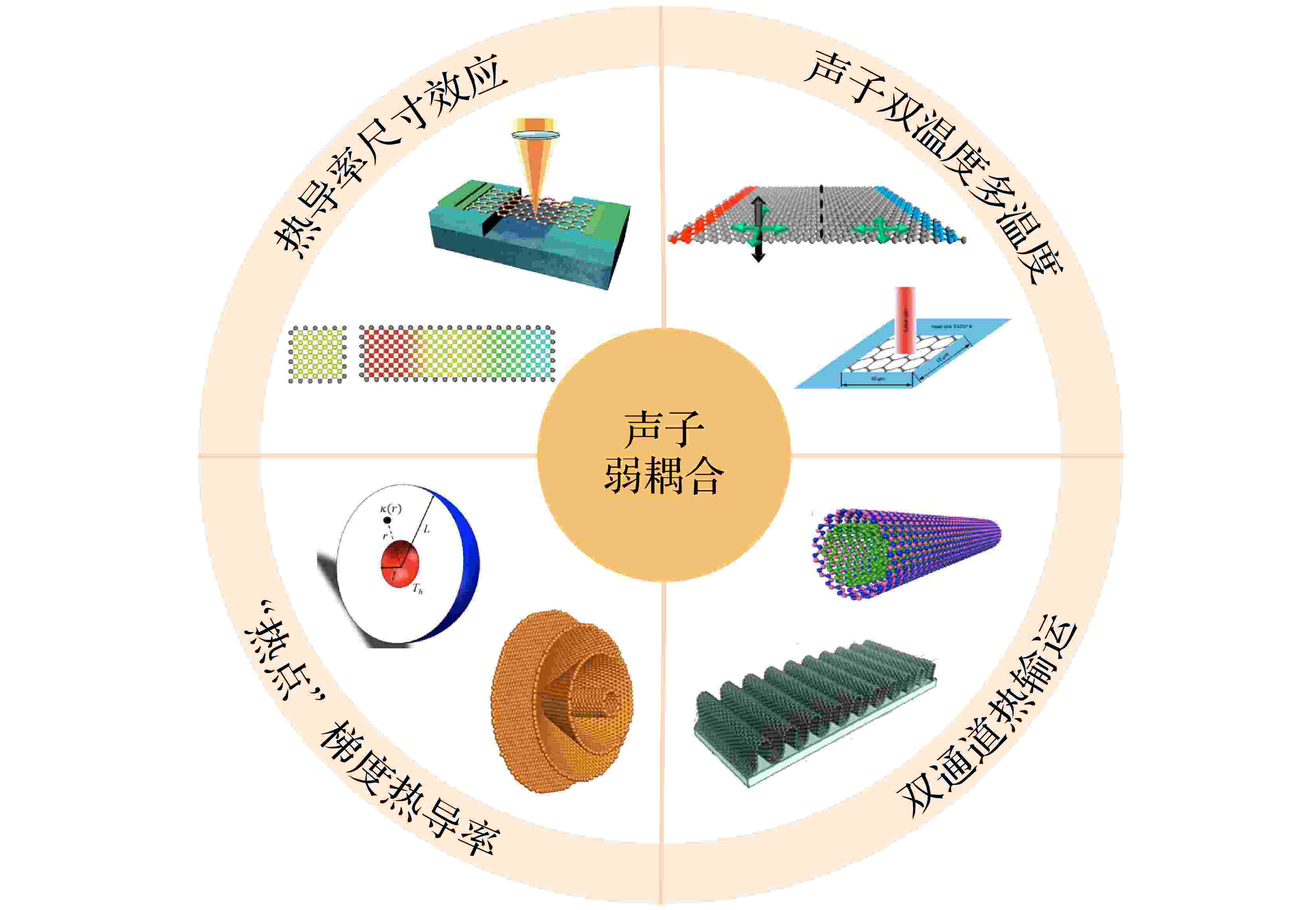
EDITOR'S SUGGESTION
2022, 71 (8): 086302.
doi: 10.7498/aps.71.20220036
Abstract +
With the development of nanoscale thermophysics, a vast number of novel phenomena have emerged, which closely relate to phonon weak couplings. The causes of phonon weak couplings mechanism and related physical discoveries are discussed in this article, including the size effect of low-dimensional systems, multi-temperature model, and van der Waals cross interfaces. Corresponding frontier researches are also summarized. The current problems of phonon weak couplings, such as how to add phonon wave-like behaviors into the theoretical model, are also briefly discussed and prospected.
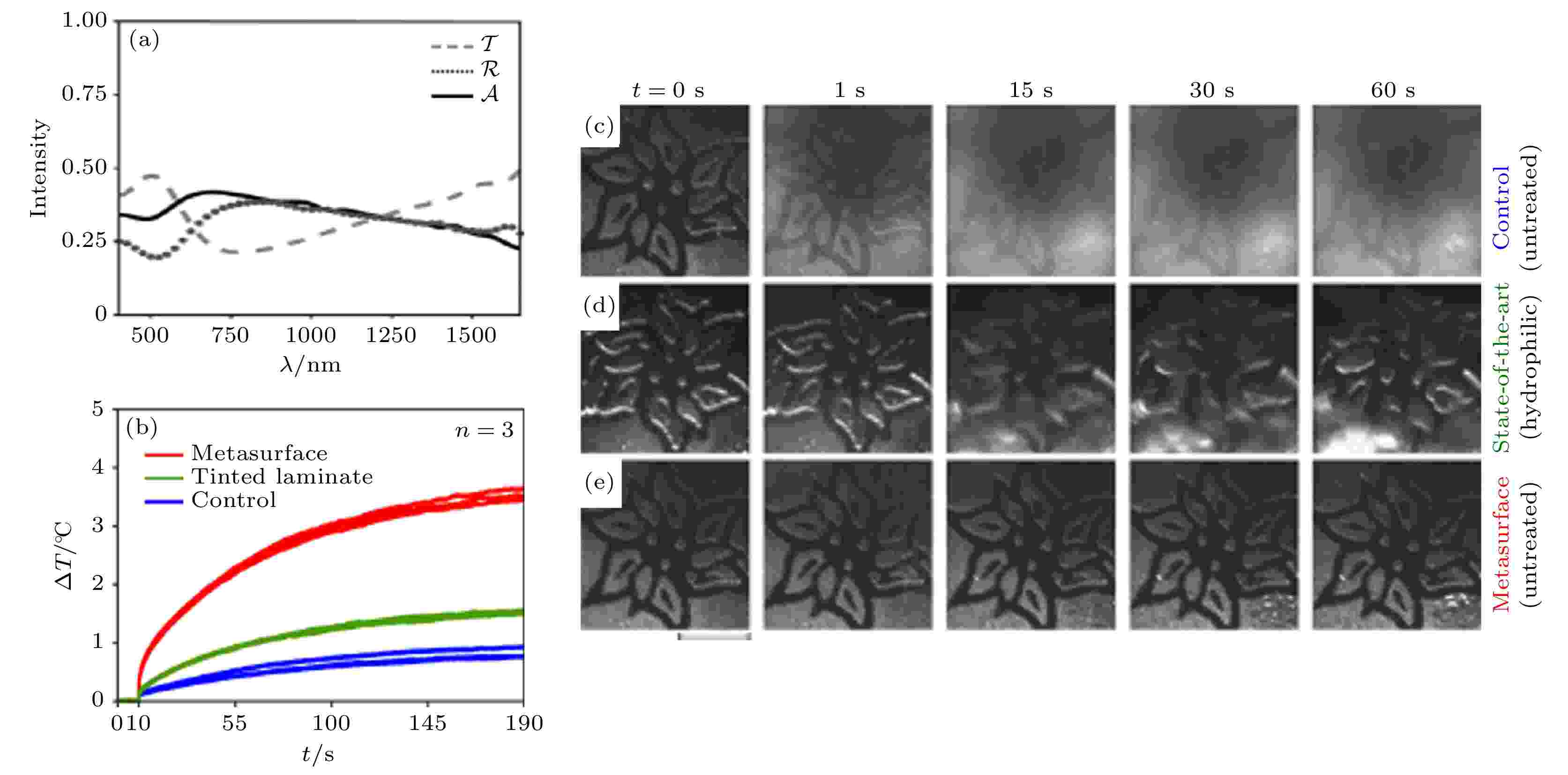
2022, 71 (8): 089201.
doi: 10.7498/aps.71.20212277
Abstract +
Icing, frosting, and fogging are all natural phenomena in cold climates, which bring a lot of inconvenience and safety problems to our daily life and industry when formed on the infrastructures. Solar-thermal anti-icing, anti-frosting or anti-fogging surfaces have attracted a lot of interest due to their effectiveness and green ecofriendly features in comparison with the conventional mechanical, thermal, and chemical methods. This short review aims at summarizing the recent progress of solar-thermal anti-fogging/anti-icing/anti-frosting surfaces. First of all, both the fundamental of solar-thermal energy conversion and the mechanism of solar-thermal anti-fogging/anti-icing/anti-frosting are introduced. After that, recent advances in solar-thermal anti-fogging surfaces, and superhydrophobic solar-thermal anti-icing/anti-frosting surfaces are summarized according to the categories of photothermal materials. The results of our collaborative research groups in this field are highlighted in this review. In the end, through comparing those reported surfaces, we point out the bottlenecks in the existing researches of this field, and suggest the potential significant research directions in the future.
REVIEW

EDITOR'S SUGGESTION
2022, 71 (8): 084301.
doi: 10.7498/aps.71.20211950
Abstract +
With the continued global warming, polar science has become one of the research hotspots. Regarding polar acoustics, much progress has been made due to the efforts made by scientists in the world. With the enhancement of stereoscopic monitoring capacity in polar regions, the acoustic theory and technologies applicable to Arctic sea-ice, which have long been overlooked as a branch of acoustics, are now dawning more and more attention. The propagation of elastic waves in the Arctic sea-ice is governed by its waveguide, and the understanding of which faces a grave challenge due to the unique material properties and complex internal structure of sea-ice, along with the asymmetric fluid-solid coupling at its boundaries and the inaccessibility for in-situ experiments, which is caused by the extreme condition. Aiming at an effectively and precisely modeling technique of acoustic propagation in sea-ice, including its waveguide, in this paper, the progress, the development, and the status of corresponding researches are reviewed. For a better understanding of the modeling of sea-ice, Arctic sea-ice, i.e. its formation condition, geometries, mechanical properties, microstructures, and the acoustic propagation, is briefly introduced. Different approaches to modeling the propagation of elastic waves in ice-floe based on explicit/implicit boundary conditions are presented and explained in detail. The resulting transcendental characteristic equation describing the acoustic propagation needs to be solved in a complex space for the severe energy leakage at the water-ice interface, and the necessary numerical methods of solving this equation are then explained and compared with each other. Since accurate parameters are imperative in having a satisfactory fidelity for any physical model, the acoustic parameters of Arctic sea-ice, historical evolution and experimental results, along with its assessment techniques are also presented, and a set of sound velocity parameters of Arctic sea-ice are provided for modeling. The roughness of the ice-water interface is discussed case-by-case depending on its spatial scale in comparison with acoustic wavelength for its influence on the elastic waveguide. The perspectives and potential applications of the sea-ice acoustic waveguide within the frame of promoting sustainable development of the polar region are also discussed.
GENERAL
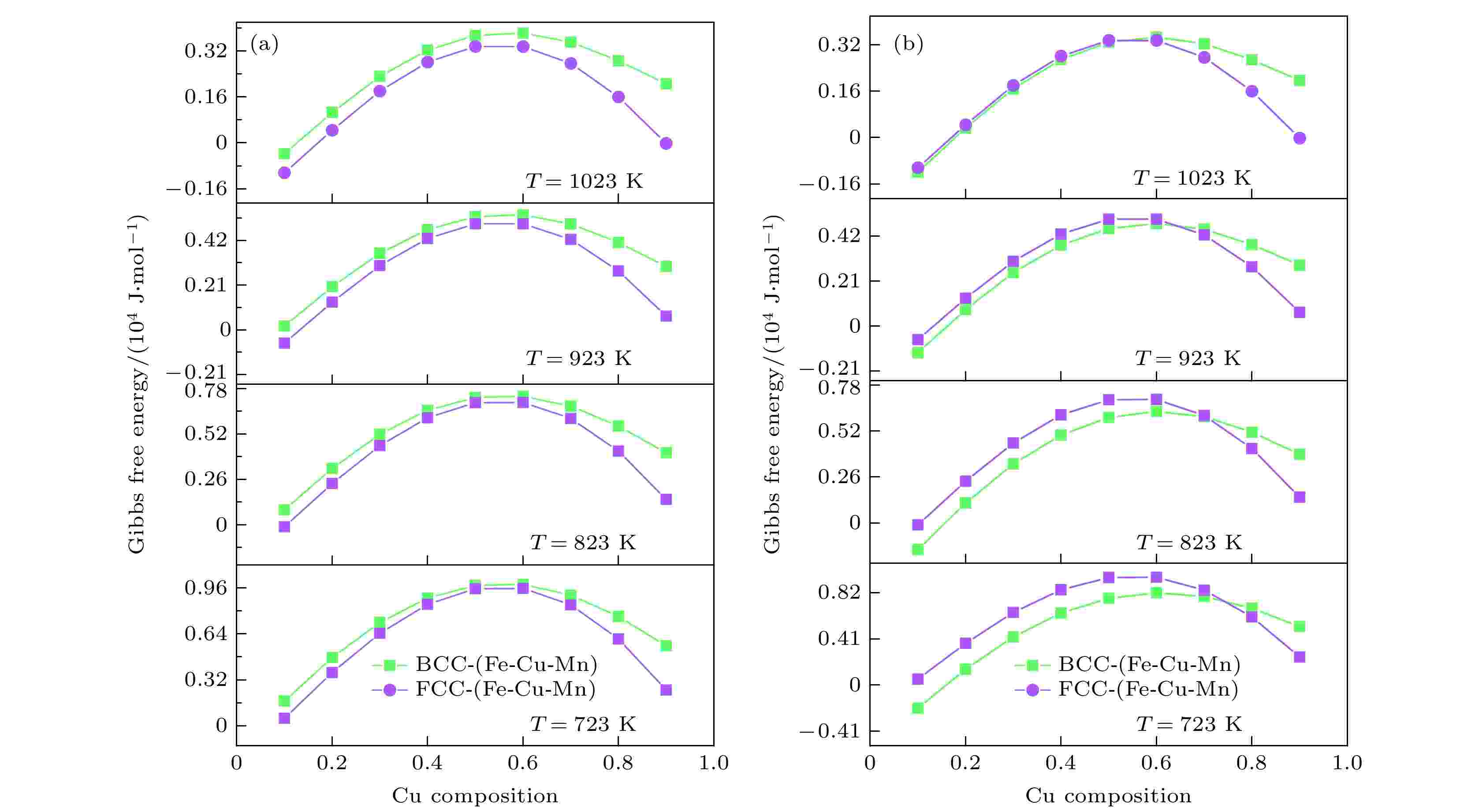
2022, 71 (8): 080201.
doi: 10.7498/aps.71.20212087
Abstract +
Based on the continuous phase field model, the precipitation behavior of Cu rich phase in Fe-Cu-Mn alloy under the action of internal magnetic energy is studied. The effects of internal magnetic energy on the average particle radius, volume fraction and Gibbs free energy of Cu rich phase at different temperatures and different Mn content and Cu content are investigated. The simulation results show that the lower the Mn content and the higher the Curie temperature, the greater the contribution of internal magnetic energy to free energy is, and the contribution of internal magnetic energy decreases with temperature increasing. The internal magnetic energy reduces the phase structure transition barrier and promotes the phase structure transition. The volume fraction of precipitated phase increases with Cu content increasing. Compared with the effect of internal magnetic energy on the volume fraction of precipitated phase, the effect of internal magnetic energy leads to a large volume fraction of precipitated phase. Therefore, under the action of internal magnetic energy, the Cu rich phase has larger average particle size, volume fraction and smaller coercivity. Finally, the change trend of alloy hardness is predicted.
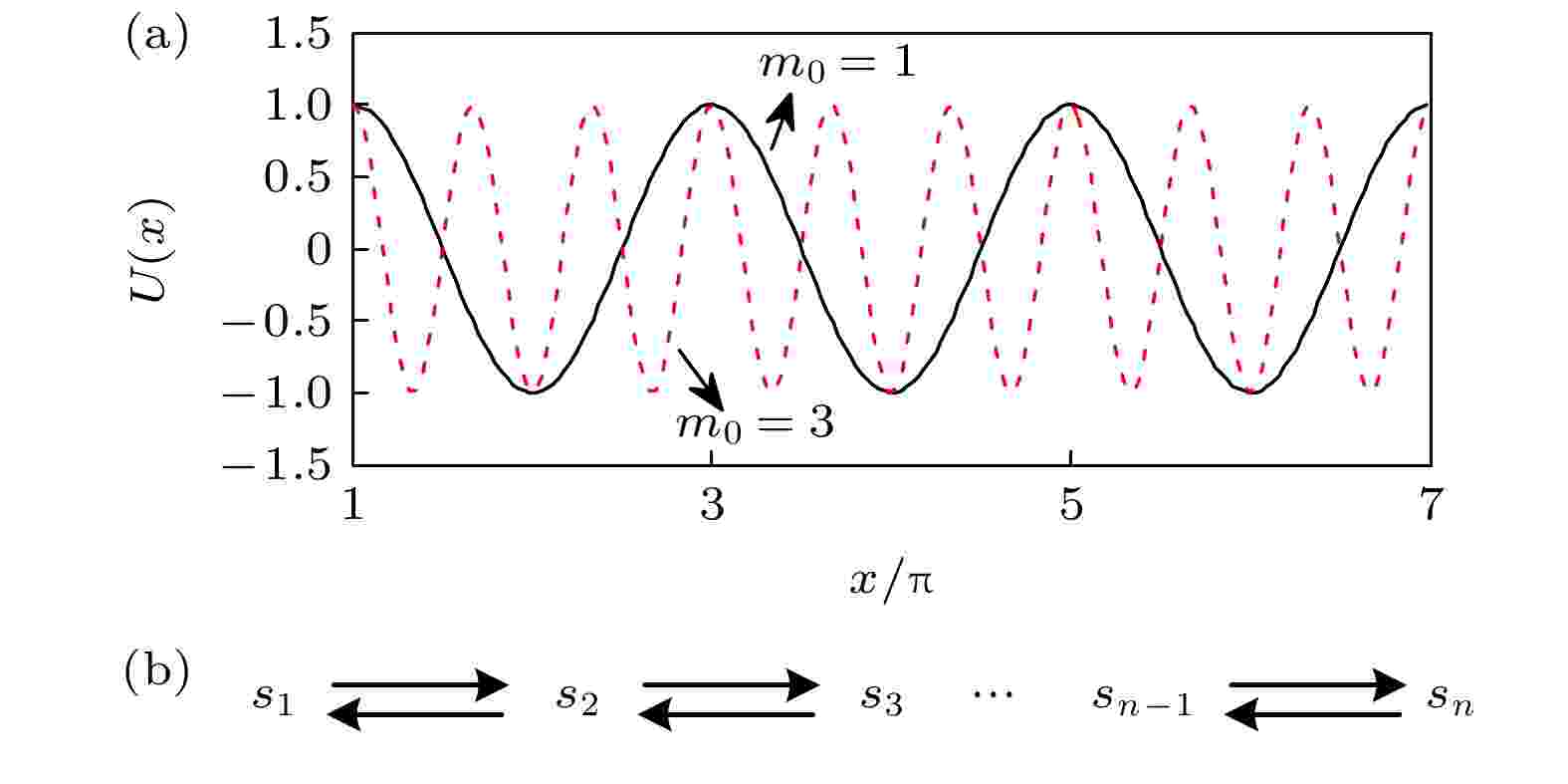
2022, 71 (8): 080501.
doi: 10.7498/aps.71.20211732
Abstract +
The stochastic dynamical system with memory effects describes a non-Markovian process that can happen in some complex systems or disordered media, such as viscoelastic media and living cell. Its velocity yields the memory effects because of the nonlocality in time, giving rise to a generalized Langevin equation for describing the dynamics of the system. In particular, the friction term in generalized Langevin equation is given by the time-dependent memory kernel. Besides, the research of stochastic resonance in periodic potential models emerges as an important subject because such systems have potential applications in diverse areas of natural sciences. However, the analysis of the influence of memory on stochastic resonance has not been reported so far in periodic potential model. In this paper, the phenomenon of stochastic resonance is investigated in the periodic potential system with friction memory kernel driven by an external periodic signal and internal noise. The generalized Langevin equation is converted into the three-dimensional Markovian Langevin equations. Analytical expression for the spectral amplification, together with the amplitude of the response, is derived in the periodic potential with an arbitrary number of simultaneously stable steady states, which can be applied to the general multi-stable dynamical model. The obtained results indicate that the curve of spectral amplification versus temperature exhibits a pronounced peak. Obviously, this typical phenomenon is a signature of stochastic resonance. The stochastic resonance effect is enhanced with the increase of the memory time or the number of stable steady states. For a certain range of the particle motion, the existence of an optimal number of stable steady states for which the output of the system can be maximized is established. Moreover, the phenomenon of stochastic resonance is studied according to the stochastic energetics. The average input energy per period is calculated over all the trajectories for quantifying stochastic resonance. It is found that the stochastic resonance effect is first weakened and then enhanced with increasing memory time. Specifically, under appropriate temperature conditions, there is an optimal memory time, which can maximize the work done by the external periodic force on the system.
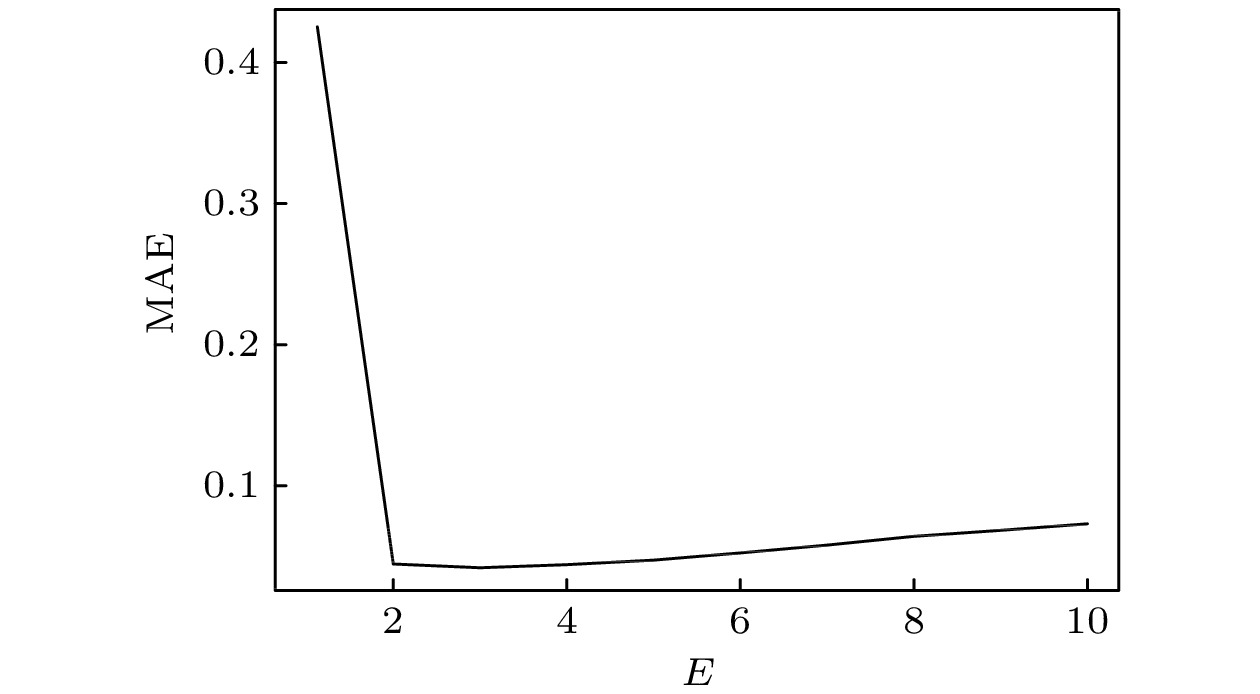
EDITOR'S SUGGESTION
2022, 71 (8): 080502.
doi: 10.7498/aps.71.20211871
Abstract +
The prediction of nonlinear and non-stationary systems is a research topic of great scientific significance. In some recent work the convergent cross mapping (CCM) algorithm is used to detect the causal relationship between variables. In the CCM algorithm, the points close to each other in the phase space have similar trends and trajectories in time. Therefore, this method can be applied to the prediction of experimental researches of nonlinear and non-stationary systems. Therefore, in this paper the CCM algorithm is applied to the prediction of the Lorenz system and the actual climate time series, and the effects of different phase space reconstruction methods on the prediction skill are investigated. The preliminary results are as follows. 1) No matter whether the ideal Lorenz model or the actual climate series, of the three reconstruction phase space methods of univariate, multivariate, and multiview embedding method, the multiview embedding method is the best predictive skill, indicating that for a given length of time series, the more the information contained in the reconstructed phase space, the stronger its predictive ability is. 2) Adding the data of NAM (northern hemisphere annular mode) to the reconstructed phase space of SAT (surface air temperature) can improve the prediction effect on prediction of SAT. Using the univariable, multivariable, and multiview embedding method for implementing prediction, the characteristics of common information in the complex system are considered. On condition that the length of the time series is fixed, the complexity of the dynamic system can be used to increase the information of the system. Based on causality detection, through the extraction of quantitative information of data, a novel idea for the improvement of predictive skills in nonlinear and non-stationary systems can be obtained.
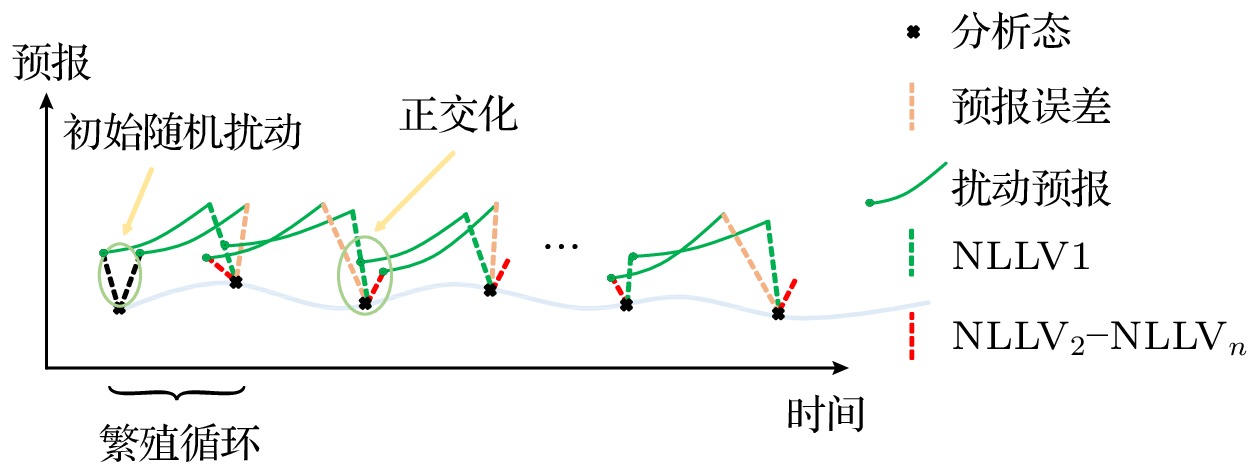
2022, 71 (8): 080503.
doi: 10.7498/aps.71.20212260
Abstract +
In this study, the feasibility and effectiveness of machine learning algorithm to improve ensemble forecasts using nonlinear local Lyapunov vectors (NLLVs) are explored preliminarily based on the Lorenz96 model. The results show that the machine learning model (Ens-ML) based on the ridge regression algorithm and the results of NLLV ensemble forecasting can effectively improve the overall forecasting skill. The Ens-ML outperforms the ensemble-averaged forecasting (EnsAve) and control forecasts (Ctrl) as well as the machine learning model based on Ctrl results (Ctrl-ML). It is also found that the improvement of forecasting skill depends on the total number of ensemble members used in the Ens-ML model, i.e. the increase of the number of ensemble members is conducive to the improvement of forecasting skill and to the decrease of overfitting in the early stage. By comparing the performances among different experimental cases, we find that the experimental forecasting errors of Ens-ML, Ctrl-ML and EnsAve are gradually smaller than that of Ctrl as the forecasting time increases. The attractors forecasted by Ens-ML, Ctrl-ML and EnsAve are also analyzed. Their attractor probability distributions show a contraction of the value domain, an increase in kurtosis and a convergence to the mean, especially for Ens-ML.
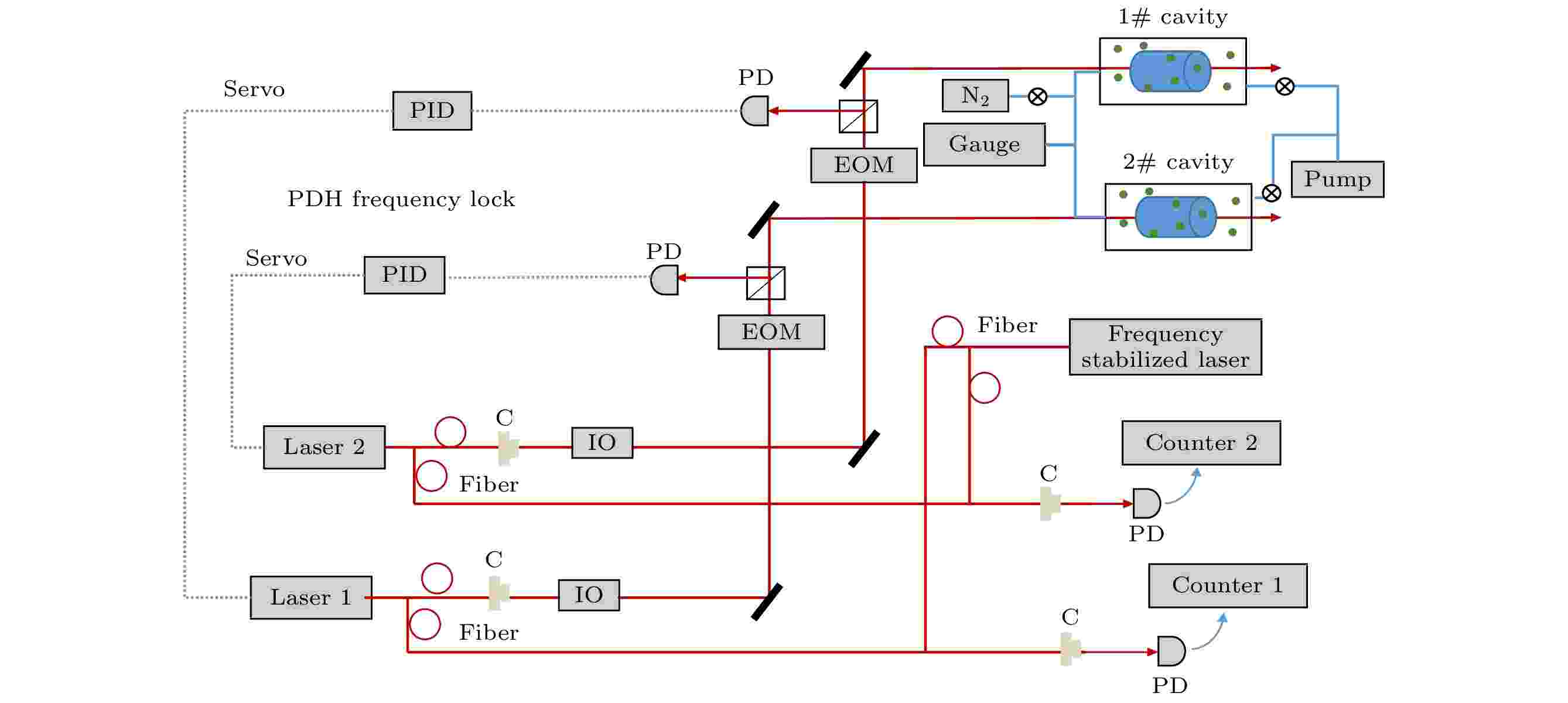
2022, 71 (8): 080601.
doi: 10.7498/aps.71.20212234
Abstract +
A gas pressure measurement device is built based on the gas refractive index method, and the measurement range is from 10 kPa to 100 kPa, and the device is tested by a dual-cavity comparison method. The temperature of the two vacuum chambers is separately controlled and the two cavities are connected to ensure that the gas pressures in the two cavities are the same. Using high-purity nitrogen (6N) as the gas medium, under the condition of different gas pressures, the dual-cavity comparative measurements are conducted. The results show that the optical pressure gauge has a repeatability better than 30 × 10–6, which is significantly better than the commercial capacitive pressure gauge, indicating that this method has great potential applications. Sources of error and uncertainty in the measurement are analyzed, and it is planned to design a new system to improve the measurement.

2022, 71 (8): 080701.
doi: 10.7498/aps.71.20212031
Abstract +
Faraday rotation spectroscopy (FRS) is generally used to detect the concentrations of various paramagnetic trace gases because of its high detection sensitivity, zero background noise and the ability to get rid of the interference of diamagnetic materials effectively. In most of FRS technologies, the used electromagnetic fields are produced by coils, thereby triggering off some problems such as high energy consumption and excessive heat generation. Thus the modeling and the simulation study of spatial magnetic field distribution based on the combined ring permanent magnets are carried out to establish an axially distributed homogeneous magnetic field and provide a permanent magnet-based homogeneous magnetic field along the optical axis for FRS measurement. In this simulation, the method of finite element mesh division is adopted based on basic electromagnetic relationship in Maxwell equations. By the simulation study of the magnetic field distribution of the actual Nd-Fe-B permanent magnet magnetic ring array, the physical model proves to be reliable. Basically, three methods of optimizing the permanent magnetic ring arrays. i.e. single ideal value optimization method, the multi-part single objective optimization method, and the gradient optimization method, are proposed. The single ideal value optimization method and the multiple ideal value optimization method are used to realize the optimization of magnets. However, by analyzing the two methods, it is clear that compared with the single ideal value optimization method, the multiple ideal value optimization method in which the whole region is divided into several small parts can achieve good uniformity of permanent magnet array. In this way, the third method, i.e. the gradient optimization method is used to realize the construction of a homogeneous magnetic field with a uniform central axis magnetic flux density distribution used for FRS. Finally, the standard magnetic field uniformity for measuring the quality of magnet field is suggested, and through the calculation and evaluation of the magnetic field uniformity, the optimization effects of different optimization methods are analyzed and compared with each other. And the final results about realizing a homogeneous magnetic field provide a reference for developing the FRS equipment based on permanent magnets.
NUCLEAR PHYSICS
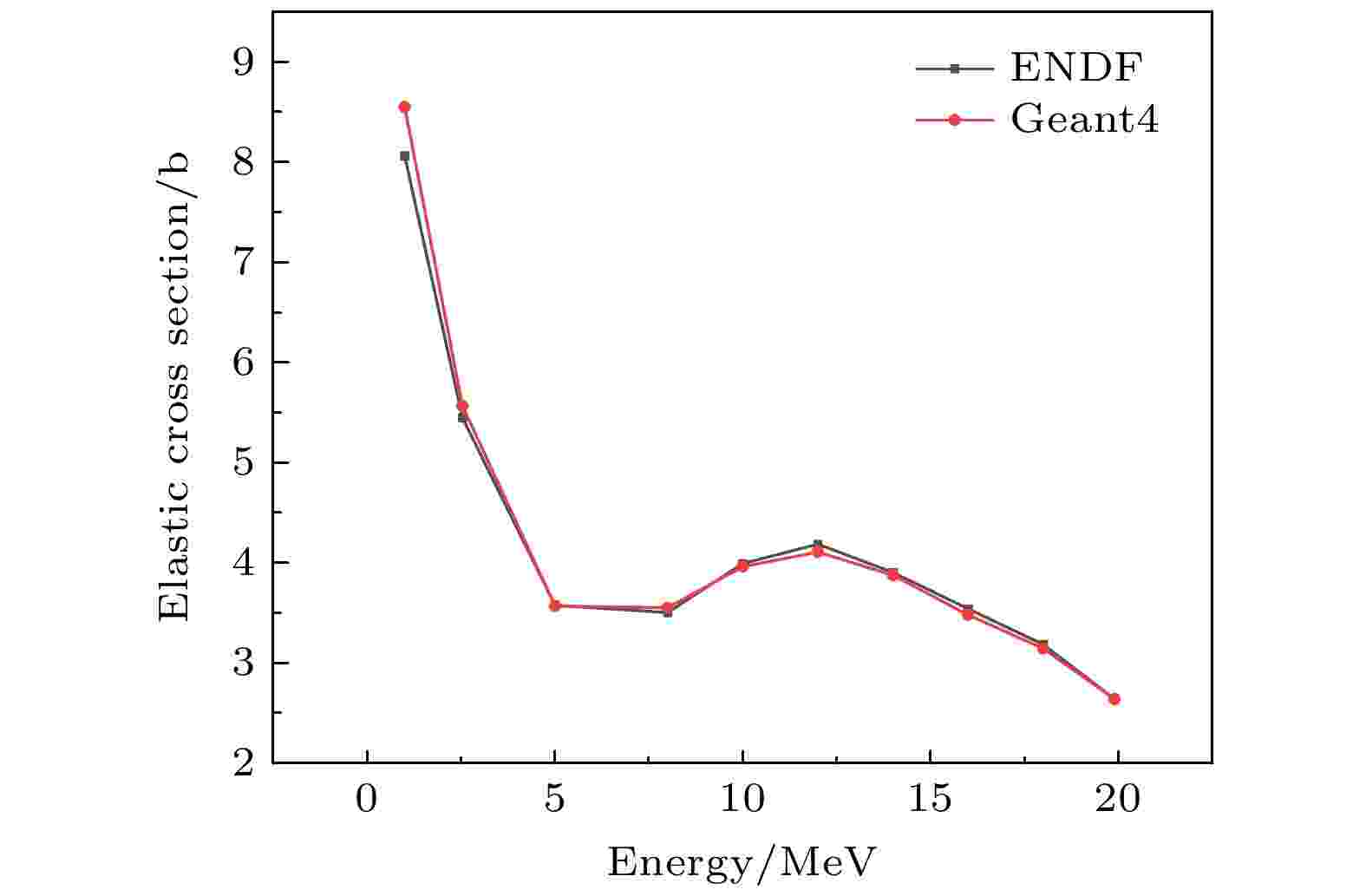
2022, 71 (8): 082401.
doi: 10.7498/aps.71.20211722
Abstract +
As the second-generation compound semiconductor material, indium phosphide (InP) has strong irradiation resistance and high photoelectric conversion efficiency. It has advantages in the field of photonics and radio frequency. In atmospheric space, high-energy cosmic rays enter into the earth’s atmosphere and interact with nitrogen (N), oxygen (O) and other elements to produce secondary cosmic rays. The irradiation particles in the atmosphere are mainly neutrons because the penetration of charged particles is weak. The InP semiconductor devices are affected by atmospheric neutron irradiation of various energy from all directions, which results in the internal defects in InP crystals, the degradation of device performance and the reduction of device lifetime. In this paper, Monte Carlo simulation software Geant4 is used to simulate the neutron irradiation effect, and the initial state distribution of displacement damage caused by neutrons with different energy is obtained, including the distribution of non-ionized energy loss (NIEL) with depth, the relationship between NIEL and the energy of incident neutrons, and the type, number and energy of primary knock-on atoms (PKA). The results show that 1) the NIEL is uniformly distributed when material thickness is on the order of μm and for the material thickness on the order of cm and more, the NIEL decreases as the depth increases and can be reduced to zero when the target material is thick enough; 2) by analyzing the NIEL produced by 1–20 MeV neutrons incident on 3-μm InP and their distribution with depth, it is found that the NIEL first increases and then decreases with incident neutron energy increasing. This trend is caused mainly by PKA produced through the inelastic scattering reaction; 3) by analyzing the type and the energy of PKA produced by 1–20 MeV neutrons incident on 3 μm InP, it is found that the PKA of In/P accounts for a large proportion, which causes displacement damage mainly, and the higher the neutron energy, the richer the variety of PKA is and the greater the maximum kinetic energy of PKA, but the PKAs mainly distribute in the low energy part. The present research has theoretical and guiding value for the long-term application of InP-based 5G devices in atmospheric neutron irradiation environment.
ELECTROMAGNETISM, OPTICS, ACOUSTICS, HEAT TRANSFER, CLASSICAL MECHANICS, AND FLUID DYNAMICS
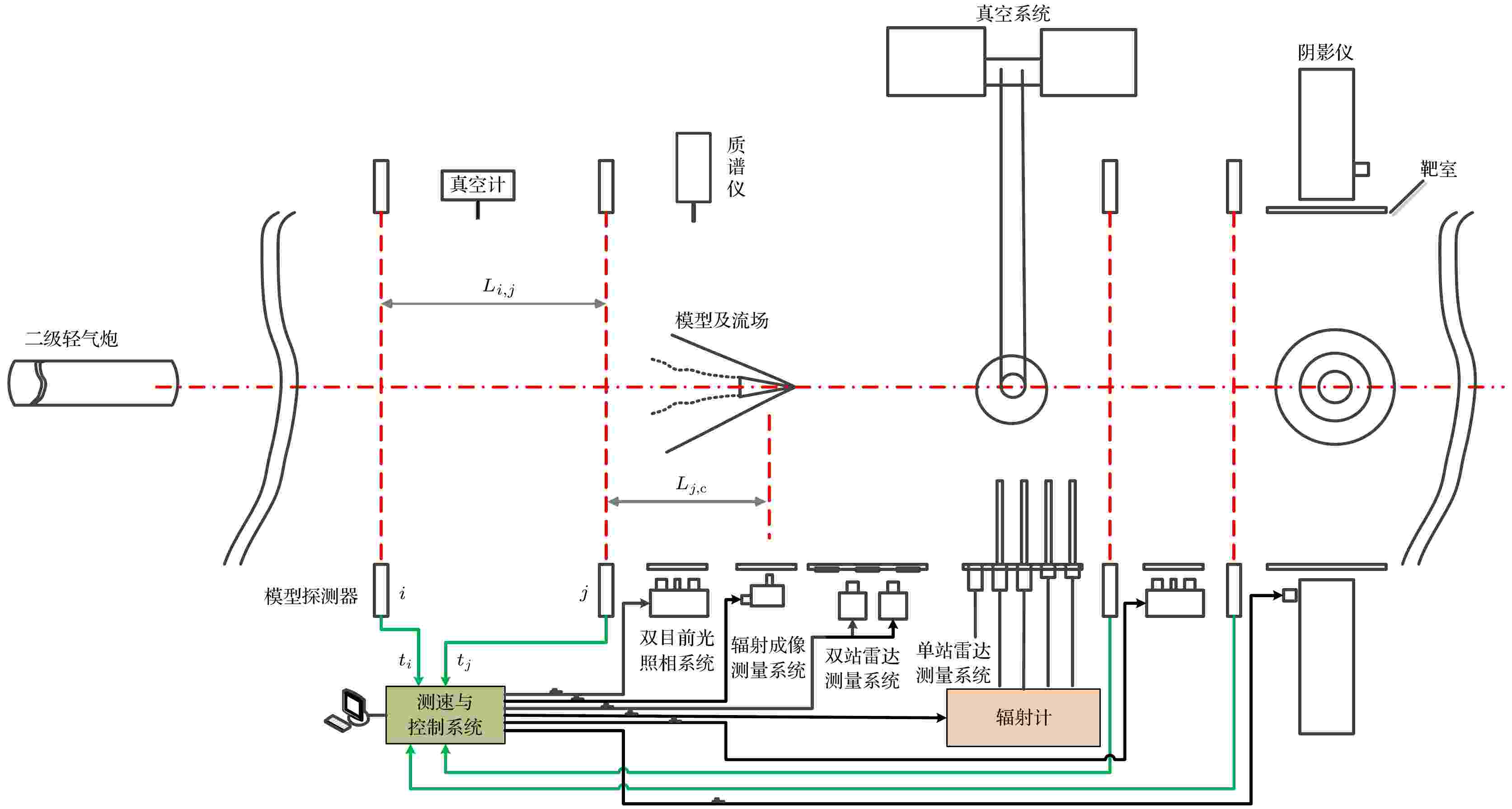
2022, 71 (8): 084101.
doi: 10.7498/aps.71.20211901
Abstract +
According to the requirements for target detection and recognition of hypervelocity vehicles in near space, the simulation and measurement of corresponding electromagnetic scattering characteristics of non-uniform plasma generated by hypervelocity targets are conducted. A numerical calculation method with dynamic plasma parameters is developed and hypervelocity HTV2-like models launched by the ballistic ranges are used to simulate complex shape target flying at a hypervelocity velocity. The high-precision shadow imaging systems and radar measurement systems of the ballistic range are used to measure the model postures, the electromagnetic scattering characteristics of the whole targets and their flow fields in both C band and X band. The experimental measurement results of the radar cross section (RCS) of the models and their flow fields under different experimental conditions are obtained. The results show that the numerical simulation methods of unsteady high-temperature ionized air flow can be used to simulate the unsteady thermal chemical flow fields around the head and body of the simplified hypervelocity HTV2-like flight models. The electromagnetic scattering characteristics of the models and their plasma sheath differ by more than one order of magnitude under different experimental conditions. The total RCS of the model’s wake in the C band is much smaller than that of the model, and the total RCS of the model’s wake in the X band is significantly enhanced. The attitude angles of the models have great influence on their electromagnetic scattering characteristics and their RCSs with different attitude angles can differ by one order of magnitude. The electromagnetic scattering energy of the model in the C band is distributed mainly around the targets and their flow fields surrounding them. The X band electromagnetic scattering energy of the model is distributed mainly in the regions around the targets, surrounding flow fields and the wake flow fields. According to the experimental conditions of the ballistic range, the numerical simulation analyses of the electromagnetic scattering characteristics of the models and flow fields around them are carried out, and the maximum error between simulation and experimental results is less than 4 dB, verifying the effectiveness of the modeling methods of simulating electromagnetic scattering characteristics of non-uniform plasma coated targets.

2022, 71 (8): 084102.
doi: 10.7498/aps.71.20212174
Abstract +
Wider band and deeper radar cross section (RCS) reduction by lower profile is always a very noticeable subject in stealth material researches. Most of researchers have designed and measured the RCS reduction bandwidth with 10 dB standard, that is, the return energy is reduced by 90%. In this paper we present a dual-mechanism method to design a single-layer absorptive metasurface with wideband 20-dB RCS reduction by simultaneously combining the absorption mechanism and the phase cancellation mechanism. Firstly, the impedance condition for 20-dB RCS reduction is theoretically analyzed considering both the absorption and the phase cancellation based on the two unit cells, and the relationship between the surface impedance and the reflection phase/amplitude is revealed. According to these analyses, two unit cells with absorption performance and different reflection phases are designed and utilized to realize the absorptive metasurface. Then, we simulate the plane case and the cylinder case with the designed flexible metasurface and compare them with the counterparts with equal-sized metal. Finally, the sample is fabricated and characterized experimentally to verify the simulated results. Both numerical and experimental results show that the 7-mm-thick single-layer absorptive metasurface features a wideband 20-dB RCS within 6.10–12.15 GHz (66%). Our designed metasurface features wideband, 20-dB reduction, polarization insensitivity, light weight and flexible, promising great potential in real-world low-scattering stealth applications.

2022, 71 (8): 084103.
doi: 10.7498/aps.71.20211337
Abstract +
Metal nanostructures have great potential for generating and regulating structural color. In this paper, an array structure based on silver nano asymmetric coaxial cavity is designed to study the influence of ring cavity on the generation and regulation of structural color. The ordered array of asymmetric coaxial cavity is simulated by the finite difference time domain method, and the influence of structural parameters on structural color is obtained. The results show that by adjusting the depth, opening size and thickness of coaxial cavity, the rich structural colors can be produced. The experimental results and the simulation results are basically consistent with each other. Compared with the coaxial cavity with symmetrical structure, the asymmetric metal nanostructure proposed in this work has good adjustability in color display, and has potential applications in color imaging, high-resolution imaging, anti-counterfeiting, and so on.

2022, 71 (8): 084104.
doi: 10.7498/aps.71.20212335
Abstract +

2022, 71 (8): 084201.
doi: 10.7498/aps.71.20212086
Abstract +
Doppler asymmetric spatial heterodyne spectroscopy is recently developed for spaceborne measurement of middle and upper atmospheric wind field, which relies on the accurate inverse of interferogram phase to calculate the Doppler shift of airglow emission lines. The change of temperature leads the optical and mechanical components to thermally deformed, causing the imaging plane to thermally drift relative to the detector, changing the distribution of interferogram phase on pixels, and directly introducing phase errors to affect the wind speed inversion. In order to reduce the influence of imaging thermal drift on phase inversion, the segmented fitting method is used in this paper to detect the sub-pixel edges of notch patterns and monitor imaging thermal drift accordingly. In the thermal stability test of a near-infrared Doppler asymmetric spatial heterodyne interferometer prototype, the thermal imaging drifts and ambient temperature show a high consistency in the trend of high-frequency oscillation, and the correlation coefficient can reach 0.86 after removing the baseline. After phase correct by using the thermal imaging shift, the high-frequency oscillation of interferogram phase shift is also greatly suppressed. In order to further verify the accuracy of the algorithm, the influence of the data signal-to-noise ratio and the data distribution characteristic parameter errors used in the fitting on the edge detection are simulated. The results show that the edge detection accuracy is restricted mainly by the data signal-to-noise ratio and the accuracy of the fringe frequency parameters. When the error of the fringe frequency parameter used for fitting is less than 0.5%, the error of other data distribution characteristic parameters is less than 5%, and the data signal-to-noise ratio is enhanced more than 35 times, the algorithm in this paper can achieve a detection accuracy higher than 0.05 pixels.

2022, 71 (8): 084202.
doi: 10.7498/aps.71.20212090
Abstract +
In laser absorption spectroscopy, in order to improve gas detection sensitivity, optical cavity with high finesse is used to prolong the interaction path between the laser and the absorber. However, the birefringence of high reflectivity cavity mirrors generates two polarization eigenstates, and owing to the different phase shifts along the two directions, the cavity mode will be split. In this work, we first measure the cavity enhanced signal under birefringence and observe the mode split. And a model to mimic cavity enhanced spectroscopy under birefringent effect is presented, which can accurately fit the different polarization ratios at transmission. Finally, we propose a cavity ring-down signal model considering different coupling efficiencies of the two polarization directions of the cavity. Comparing with the conventional exponential model, the standard deviation of residual maximum suppression is as high as 9 times. And this analysis is helpful in improving the signal-to-noise ratio and uncertainty of cavity ring-down signal and increasing the accuracy of concentration inversion.

2022, 71 (8): 084203.
doi: 10.7498/aps.71.20212162
Abstract +
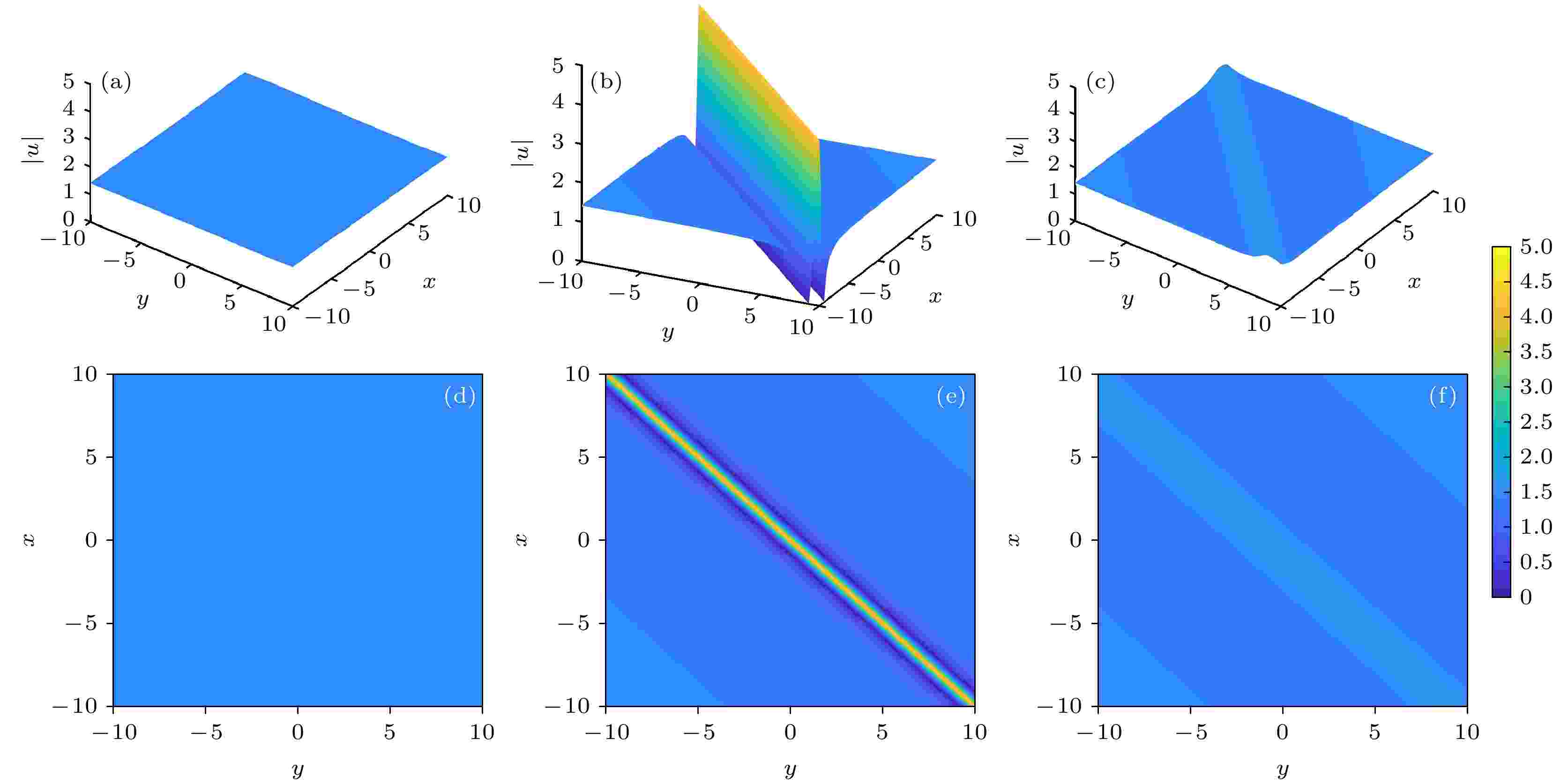
2022, 71 (8): 084204.
doi: 10.7498/aps.71.20211181
Abstract +
The search for the excitation of two-dimensional rogue wave in a (2+1)-dimensional nonlinear evolution model is a research hotspot. In this paper, the self-similar transformation of the (2+1)-dimensional Zakharov equation is established, and this equation is transformed into the (1+1)-dimensional nonlinear Schrödinger equation. Based on the similarity transformation and the rational formal solution of the (1+1)-dimensional nonlinear Schrödinger equation, the rogue wave excitation of the (2+1)-dimensional Zakharov equation is obtained by selecting appropriate parameters. We can see that the shape and amplitude of the rogue waves can be effectively controlled. Finally, the propagation characteristics of line rogue waves are diagrammed visually. We also find that the line-type characteristics of two-dimensional rogue wave are present in the x-y plane when the parameter $ \gamma = 1 $ . The line rogue wave is converted into discrete localized rogue wave in the x-y plane when the parameter $ \gamma \ne 1 $ . The spatial localized rogue waves with short-life can be obtained in the required x-y plane region. This is similar to the Peregrine soliton (PS) first discovered by Peregrine in the (1+1)-dimensional NLS equation, which is the limit case of the “Kuznetsov-Ma soliton” (KMS) or “Akhmediev breather” (AB). The proposed approach to constructing the line rogue waves of the (2+1) dimensional Zakharov equation can serve as a potential physical mechanism to excite two-dimensional rogue waves, and can be extended to other (2+1)-dimensional nonlinear systems.
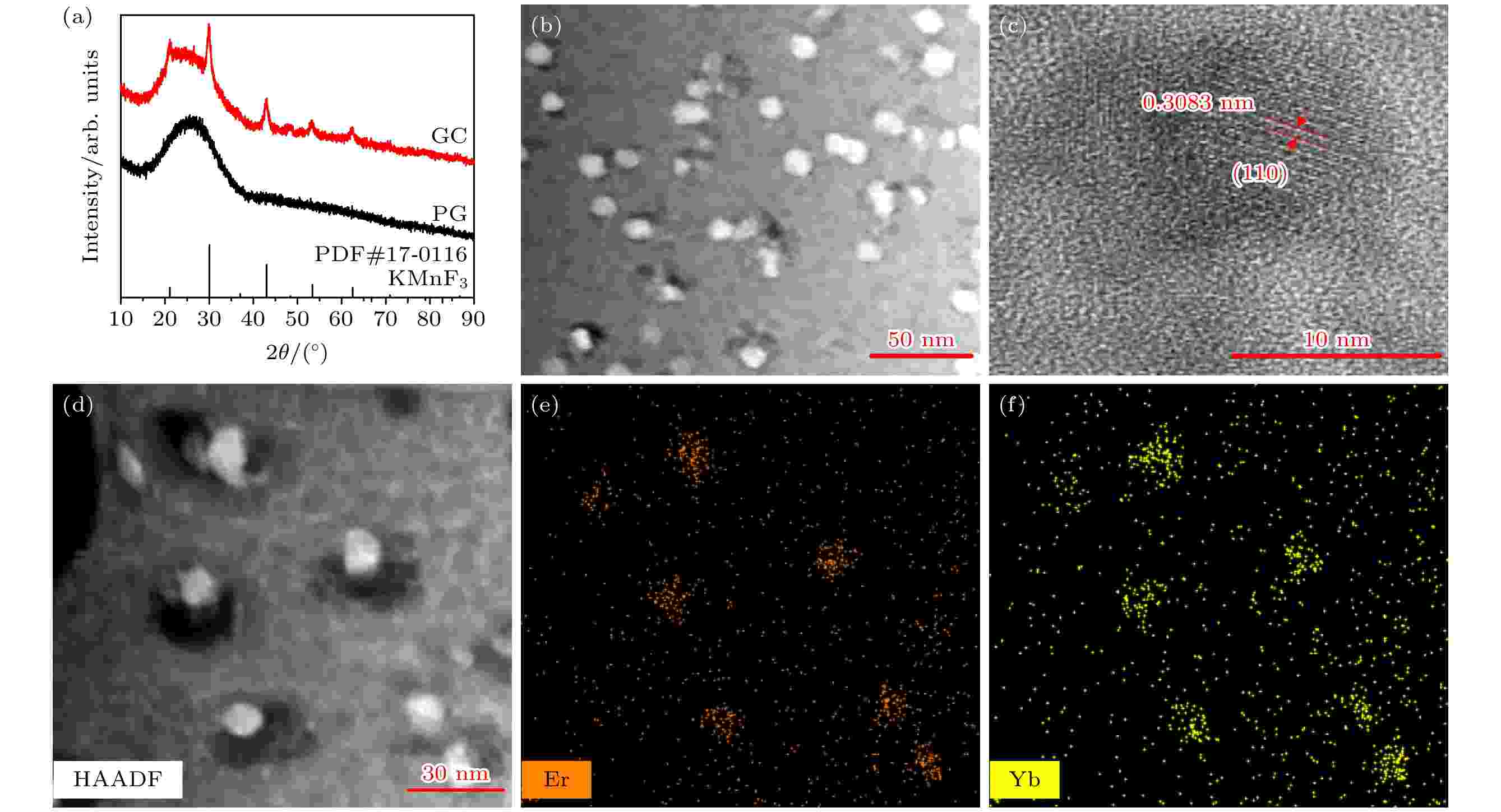
EDITOR'S SUGGESTION
2022, 71 (8): 084205.
doi: 10.7498/aps.71.20211953
Abstract +
Luminescent materials with an efficient single-(pure) color up-conversion luminescence (UCL) are expected to be applied to three-dimensional (3D) display, lighting, biological imaging, promoting plant growth and improving the photoelectric conversion efficiency of solar cells. In this work, perovskite-type KMnF3 fluoride nanocrystals (NCs) are grown in situ in a fluorosilicate glass co-doped with rare earth (RE) ions Yb3+/Er3+ by a controlled thermal treatment. Compared with precursor glass (PG), the nano-glass composites (also referred to as glass ceramics, or GC in short) thus obtained exhibit a significantly enhanced (by 6 times) red UCL emission. Although a weak green UCL emission can be also observed in the GC, the intensity ratio of the red UCL emission to green UCL emission is as high as 30, implying a good color purity. It is suggested that the dramatic enhancement of UCL emissions in the GCs is due to the doping of RE ions into the KMnF3 NCs with a much lower phonon energy (330 cm–1) than that of the silica glass matrix about 1100 cm–1. However, the doping mechanisms of RE ions into KMnF3 nano-glass composites are not yet conclusive, mainly because of the charge and ionic radius mismatch between RE ion dopants and cations of KMnF3. This work combines the high-resolution transmission electron microscopy (HR-TEM) analysis technology and the first principles calculation, to unravel the doping mechanism of RE ions in KMnF3 nano-glass composites. First, the HR-TEM study provides straightforward evidence that RE ions are preferentially accumulated in KMnF3 NCs embedded in the glass matrix. Then, through the first-principles calculation considering the charge balance, it is found that the formation energy of RE ions substituting for K+ is lower than for Mn2+ lattice sites in KMnF3, which is most likely related to the fact that the ionic radius of the eight-fold coordinated K+ is larger than that of the six-fold coordinated Mn2+ and thus is more conductive to accommodating the large size RE ions. The electronic densities of states at the top of the valence band and the bottom of the conduction band of KMnF3 increase after doping the RE ions. It is inferred from the profile of partial density of state that RE ions have a strong bonding tendency with F– in the crystal. Benefiting from the efficient energy transfer between RE ions and Mn2+ in KMnF3, the green UCL emission is dramatically quenched, and consequently, the GC is endowed with a highly pure red UCL emission. The present study is expected to deepen the understanding of RE ions doping mechanisms in NCs and facilitate the design of highly efficient UCL materials based on nano-glass composites.

2022, 71 (8): 084302.
doi: 10.7498/aps.71.20212150
Abstract +
Based on the dynamic model of a single bubble in a magnetic fluid tube, the dynamic equation of a bubble pair system in a magneto-acoustic field is established by introducing the secondary sound radiation between bubbles and considering the magnetic field effect of the viscosity of the magnetic fluid. The effects of magnetic field intensity, bubble pair’s size, bubble interaction (including secondary Bjerknes force FB and magnetic attraction Fm) and fluid characteristics on the vibration characteristics of double bubbles are analyzed. The results show that magnetic field increases the amplitude of bubbles, and the influence of magnetic field on the large bubble is greater than on the small bubble. When the center distance between the two bubbles is constant and the relative size of two bubbles is larger, or when the size of the two bubbles is constant and the surface distance between two bubbles is small, the interaction between two bubbles is stronger. In the magneto-acoustic composite field, magnetic field can affect FB, Fm, magnetic pressure Pm and viscosity resistance, and the influence degrees are different. There is competition between FB and Fm and between Pm and viscosity resistance, and the forces acting on the microbubble jointly affect the movement of the bubbles. By studying the dynamic behavior of paired bubbles, it can provide a theoretical basis for improving the therapeutic effect of targeted regulation of microbubbles on biological tissues by adjusting the magneto-acoustic field in practical application.
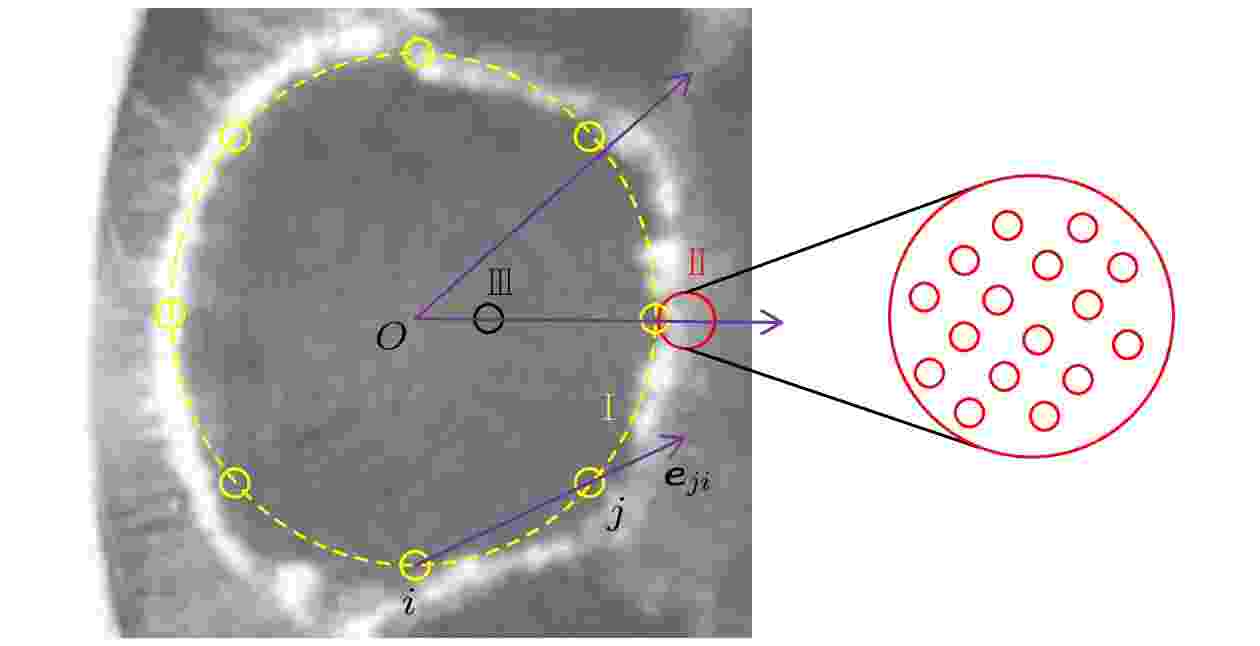
2022, 71 (8): 084303.
doi: 10.7498/aps.71.20212257
Abstract +
In this paper, the evolution of the cavitation bubbles is investigated. A model is developed to describe the cyclic chain-like cavitation cloud and analyze its structure stability in a thin liquid layer. By considering the effect of secondary acoustic radiation of bubbles, the dynamic equations of the bubbles in three zones of the cyclic chain are obtained. The secondary Bjerknes force is selected and used to explore the interaction between the bubbles in different regions. Numerical results show that the newborn bubbles inside the pure liquid zone of the thin layer can be attracted by the bubbles at the cyclic chain-like bubble chain. The bubble number density can affect the coupling strength between bubbles, and it is closely related to the driving pressure. Therefore, the structure stability of cyclic chain-like cavitation cloud can be disrupted by the perturbations of the acoustic pressure. To verify our analysis, we observe the structure of cavitation cloud in a thin liquid layer in a strong acoustic field by using a high speed camera. It is observed that the simultaneous collapse of local bubbles occurs, and pure liquid-like thin layers are distributed in the bubble cloud randomly. The boundary of the pure liquid-like thin layers oscillates with the acoustic field, and these liquid zones sustain about 4 acoustic cycles. The experimental results accord well with theoretical results.
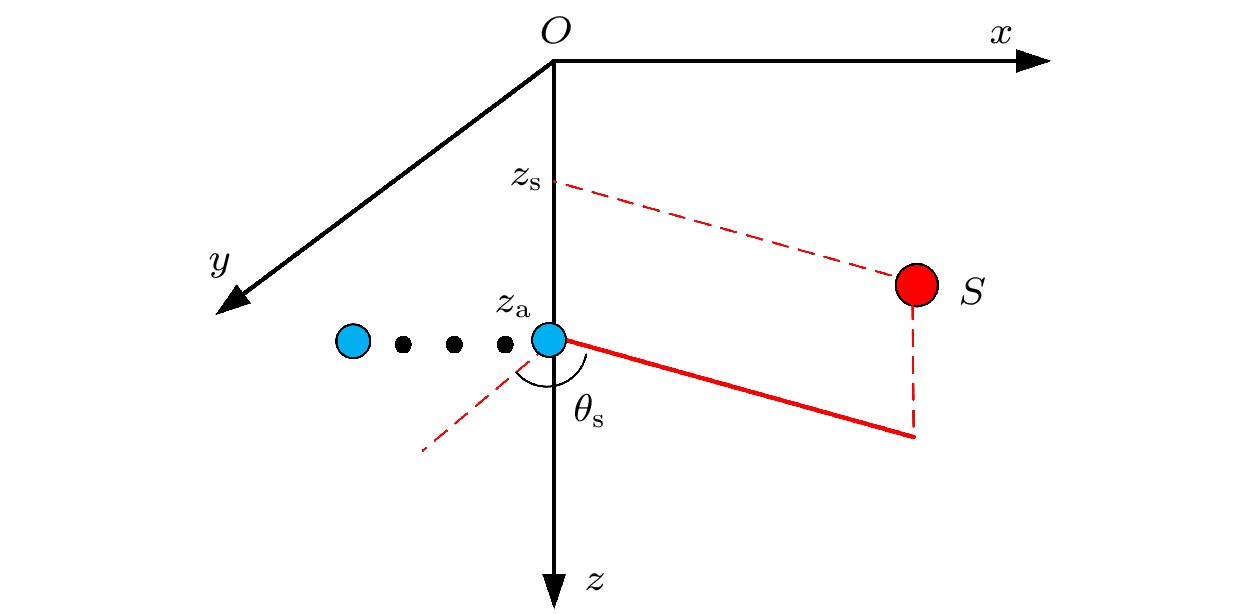
2022, 71 (8): 084304.
doi: 10.7498/aps.71.20211742
Abstract +
The uncertainties of environmental parameters affect the robustness of detection method in complex shallow water. We define and estimate the angle-domain subspaces of horizontal linear array in a proper way under an uncertain environment. According to the angle-domain subspaces, we propose an angle-domain subspace detector and its robust form. Angle-domain subspaces contain an uncertain information by using the observation matrices in different environmental parameters. The relationship between the horizontal wave number of propagating modes and the sound speed of the bottom and sediment in hard seabed is used to estimate the angle-domain subspaces. The proposed angle-domain subspace detector is robust in an uncertain environment, but its detection performance fluctuates with target bearings. The angle domain subspace is transformed into a constant dimension subspace, robust form of the angular domain subspace detector, whose detection performance is consistent in all source bearings. The simulation results in the uncertain shallow-water environment show that the robust angle domain subspace detector has a similar robustness to the energy detector, and better detection capability.
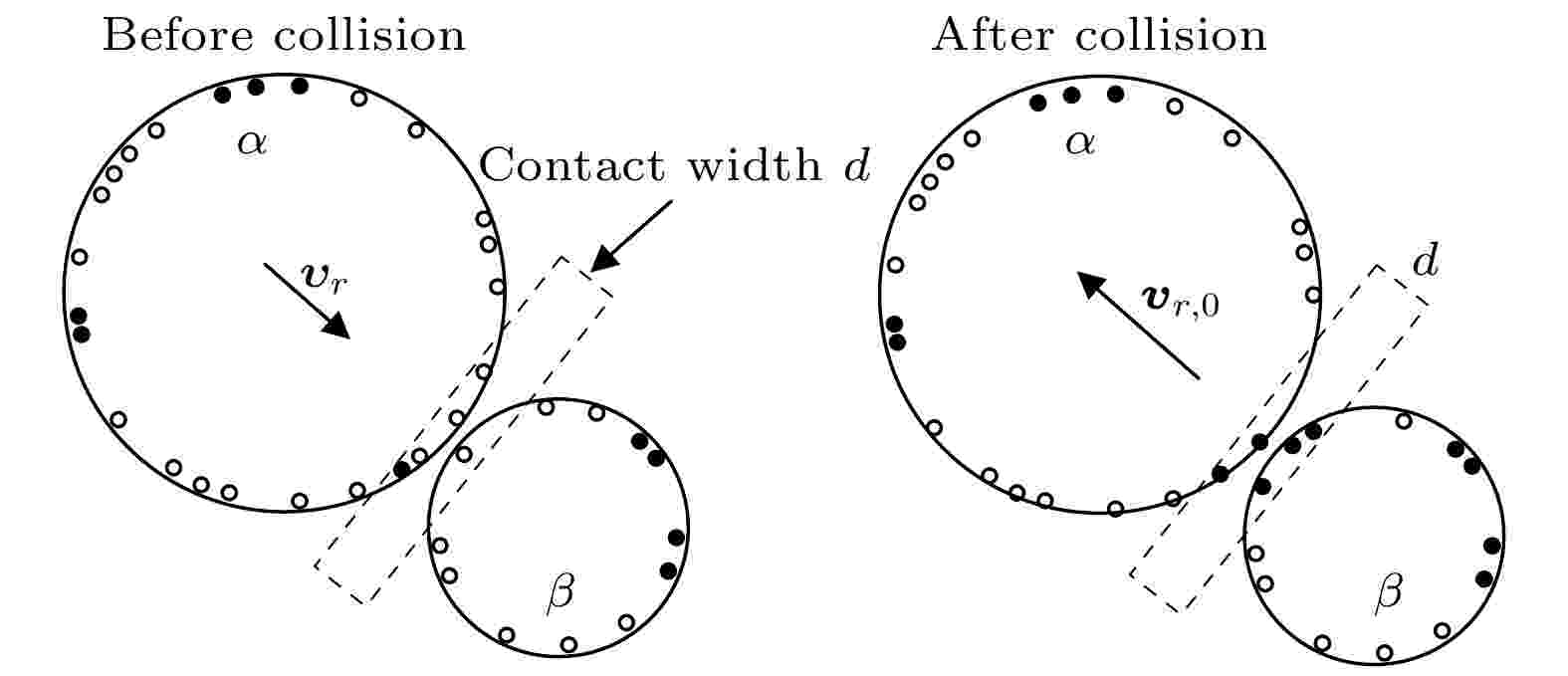
2022, 71 (8): 084501.
doi: 10.7498/aps.71.20211647
Abstract +
Triboelectrification in an insulative granular system is a common natural phenomenon, but until now it has not been well understood. The space on the moon or Mars is suffused by a large amount of fine dust. These tiny dust particles are so adhesive that they can easily stick to any exposed surfaces, which may provoke serious problems, such as reducing the efficiency of solar panels, and resulting in the thermal control failure and the false instrument readings. In recent years, dust removal by using an electrodynamic field is considered as an effective method to mitigate dust pollution. Research shows that the triboelectrification on the particle surface contributes most to the electrostatic source of lunar dust. Consequently, the study of the mechanism of triboelectrification is very important in removing dust particles. In this paper, an analytical model based on the high-energy electron hypothesis is developed to predict the triboelectric charge distribution among particles. The particle size dependence of the tribo-charge is obtained, and the influence of the size range on the tribo-charge probability is also demonstrated. An upper limit for the charge distribution is revealed, and its possible cause is discussed. The particle dynamics simulation is carried out to investigate the charge transfer during particle collisions, thereby verifying the prediction results obtained by theoretical analysis.

2022, 71 (8): 084701.
doi: 10.7498/aps.71.20212171
Abstract +
Focusing on the typical problem of flow around a circular cylinder, we propose an active flow control method of reducing drag of a circular cylinder, in which a deep reinforcement learning (DRL) method is used to establish the closed-loop control strategy with pressure sensors providing feedback signals. The detailed comparisons of the lift, drag, and flow fields with and without control are conducted. In the control system, pressure sensors evenly distributed on the cylinder surface are used to provide feedback signals for the controller. The multilayer perceptron is adopted to establish the mapping relationship between the sensors and the blowing/suction jets, i.e. the control strategy. A pair of continuously adjustable synthetic jets that exert transverse force mainly on the top and bottom edge of the cylinder is implemented. Based on the state-of-the-art proximal policy optimization algorithm, the control strategy is explored and optimized during a large number of learning episodes, thus achieving an effective, efficient, and robust drag reduction strategy. To build up the high-fidelity numerical environment, we adopt the lattice Boltzmann method as a core solver, which, together with the DRL agent, establishes an interactive framework. Furthermore, the surface pressure signals are extracted during the unsteady simulation to adjust the real-time blowing/suction jets intensity. The lift information and the drag information are recorded to evaluate the performance of the current control strategy. Results show that the active control strategy learnt by the DRL agent can reduce the drag by about 4.2% and the lift amplitude by about 49% at Reynolds number 100. A strong correlation between the drag reduction effect of the cylinder and the elongated recirculation bubble is noted. In addition, the drag reduction rate varies over a range of Reynolds numbers. The active control strategy is able to reduce the drag by 17.3% and 31.6% at Reynolds number 200 and 400, respectively. Owing to the fact that wall pressure signals are easy to measure in realistic scenarios, this study provides valuable reference for experimentally designing the active flow control of a circular cylinder based on wall pressure signals and intelligent control in more complicated flow environments.
PHYSICS OF GASES, PLASMAS, AND ELECTRIC DISCHARGES

2022, 71 (8): 085201.
doi: 10.7498/aps.71.20212115
Abstract +
As the speed of a hypersonic vehicle increases, atomic emission lines in the shock-layer will be a main source of radiative heating. Therefore, it is very important to study the atomic excitation in the air plasma in the shock layer. For a thermal nonequilibrium air plasma, the equilibrium statistical theory is not applicable. Although full models (such as the collisional-radiative model) can be used to solve nonequilibrium problems with high accuracy, they are too expensive computationally and difficult to apply to engineering. In this work, we investigate the atomic excitation in air plasmas by the bound-state characteristic temperature (BCT) method. Some cases of equilibrium and nonequilibrium air plasmas associated with the well-known FIRE II flight experiment are considered. The calculated atomic energy level populations are in good agreement with those from the CR model, thereby showing that our calculation is reasonable and has a good accuracy. The computational efficiency is more than 2000 times higher than that from the CR model. If it is used in the flow field of a hypersonic vehicle, the computational cost can be greatly reduced.
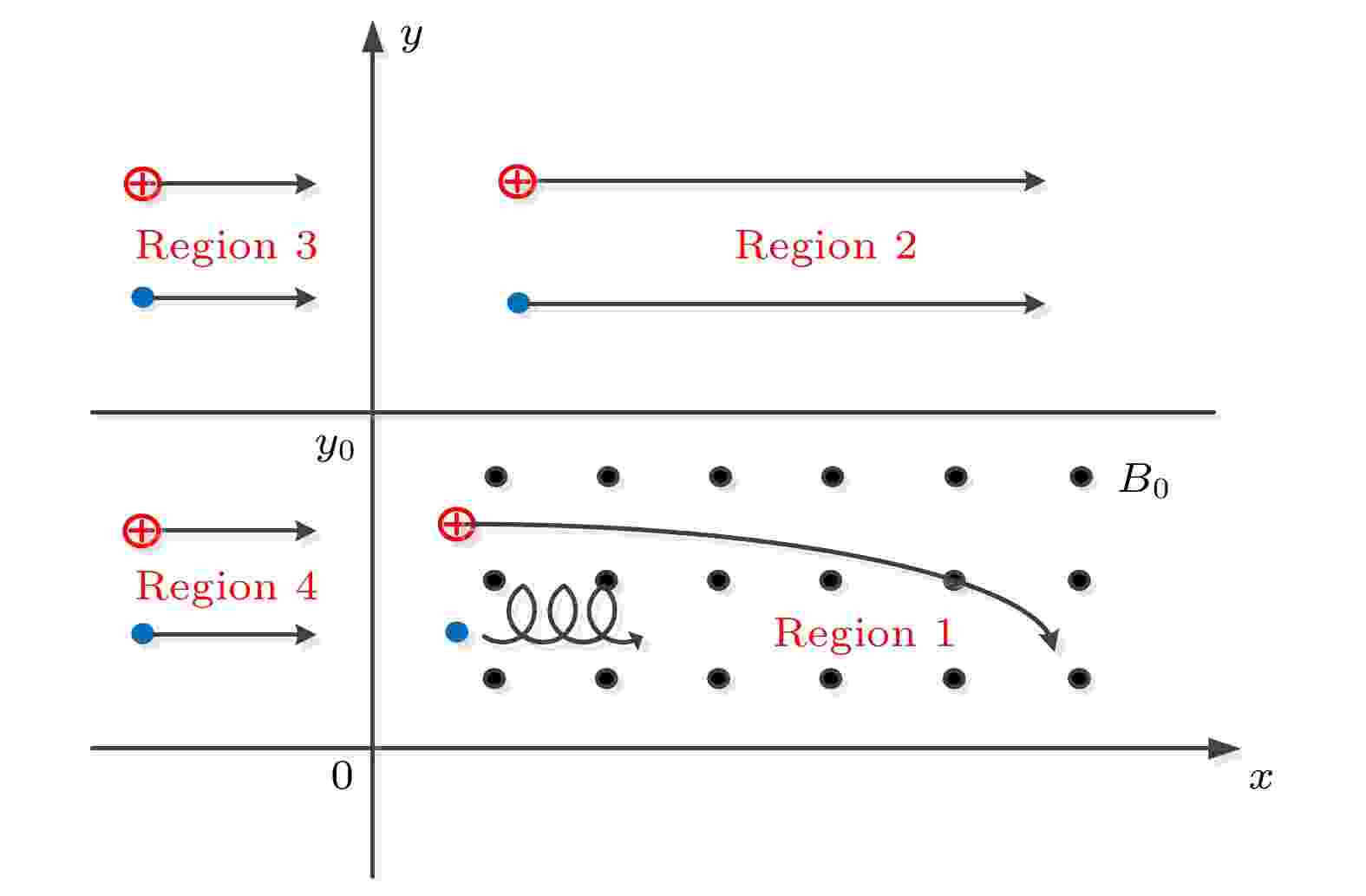
2022, 71 (8): 085202.
doi: 10.7498/aps.71.20212044
Abstract +
To enhance the radiation performance of the Beidou antenna in the near-space hypersonic vehicle, the static strong magnetic field is used to weaken the electron density in plasma surrounding the antenna. In order to demonstrate the effect of this program, a time-domain multi-physical method is proposed. In the proposed method, what is first analyzed is the reduction of electron concentration in plasma sheath by static strong magnetic field with the spectral element time domain (SETD) method, which has spectral accuracy. Then, the electron density after mitigation is extracted to replace the original electron concentration around the antenna. Hence, the distribution of the manipulated plasma sheath can be obtained. Finally, the radiation characteristics of BeiDou antenna installed in the vehicle are analyzed by the conformal finite difference time domain (CFDTD) method. The simulation results exhibit radiation patterns under different conditions. With the plasma sheath, the radiated electromagnetic waves are greatly attenuated, which will significantly affect the transmission of communication signals. Importantly, the radiation patterns are effectively improved with the external static magnetic field, confirming that it provides an effective tool to mitigate the influence of plasma sheath on the radiation performance of antenna in hypersonic vehicle.

2022, 71 (8): 085203.
doi: 10.7498/aps.71.20212151
Abstract +
A 2-cm electron cyclotron resonance ion source has the advantages of long life and high specific impulse, which can meet the requirements for space gravitational waves detection. In the experiment on finding the lower limit of thrust, it is found that when the ion source operates under the extreme condition of 0.5-W microwave power and 0.1-sccm gas flow rate, increasing the voltages of grid system excessively may cause flameout. The plasma discharge level is controlled by the gas supply, microwave, and power supply system, and their small disturbances will make experimental results different, thus the flameout of the ion source appears randomly and transiently. Besides, it is difficult to observe the flameout phenomenon experimentally, because the probe diagnosis has big interference to low-density plasma, and the optical diagnosis is blocked by the grid system. Therefore, the integrative simulation with the full particle-in-cell method is used to simulate the operating process of the ion source, whose calculation range includes the discharge chamber, grid system, and plume. Through simulating the processes of plasma discharge and ion beam extraction continuously in space and time, the flameout phenomenon can be reproduced artificially after increasing the voltages of grid system. The simulation results show that the ambipolar diffusion between the antenna and discharge chamber is the fundamental reason for the flameout of the ion source. In the circuit, the antenna does not touch the discharge chamber but for bulk plasma, which makes its surface gradually accumulate charges until it reaches the floating potential. Because the increase of the voltage of antenna lags behind that of grid system, a strong electric field will appear between the antenna and chamber. Then, electrons and ions respectively move toward the chamber and antenna, the ambipolar diffusion helps the antenna reach the floating potential rapidly. When the plasma density inside the chamber is low, the ambipolar diffusion will cause flameout. In order to avoid the flameout of the ion source in such an extreme situation, an improvement measure that the voltage of antenna equals the voltage of chamber is proposed, which is verified by the integrative simulation. The study on the flameout phenomenon will provide a theoretical basis for the design and application of the ion source, which can help the ion source operate safely to meet the requirements for space gravitational wave detection.
CONDENSED MATTER: STRUCTURAL, MECHANICAL, AND THERMAL PROPERTIES

EDITOR'S SUGGESTION
2022, 71 (8): 086101.
doi: 10.7498/aps.71.20212025
Abstract +
As a potential functional and structural material, high-entropy metallic glasses have aroused tremendous research interest in condense matter physics and mechanics. The correlation between macroscopic mechanic properties and microstructure heterogeneity of high-entropy metallic glasses is one of the most important scientific issues in glassy solids. In the present research, Pd42.5Cu30Ni7.5P20 metallic glass and Pd20Pt20Cu20Ni20P20 high-entropy metallic glass are selected as the model alloys. Dynamic mechanical analysis (DMA) and stress relaxation are used to investigate the influences of temperature and physical aging on dynamic mechanical relaxation process and microstructure heterogeneity of the model alloys. The dynamic mechanical analysis results demonstrate that the Pd42.5Cu30Ni7.5P20 metallic glass and Pd20Pt20Cu20Ni20P20 high-entropy metallic glass both exhibit evident β relaxation process. In addition, the atomic mobility of model alloys is reduced in these processes, and the β relaxation shifts toward higher temperatures. In the stress relaxation process, the Gibbs free energy is reduced due to the high configurational entropy. This is the potential reason that high-entropy metallic glass possesses higher activation energy. In parallel, high-entropy metallic glass is more difficult to activate and needs to break through a higher energy barrier. With the increase of physical aging time, the flow unit in high-entropy metallic glass becomes smaller. This also benefits from the high-entropy effects that bring sluggish diffusion into high-entropy metallic glass. The change of activation volume under physical aging of high-entropy metallic glass is less sensitive to stress relaxation than that of metallic glass.

2022, 71 (8): 086102.
doi: 10.7498/aps.71.20211999
Abstract +
In this work, Ta/BaTiO3/Al2O3 multi-layer thin film is deposited on indium tin oxide substrates by using the magnetron sputtering technology. Obvious resistive switching performance can be observed by increasing the compliance current. Ohmic and space charge limited current conduction mechanisms are demonstrated in Ta/BaTiO3/Al2O3. The reproducible and stable resistive switching behaviors in Ta/BaTiO3/Al2O3/ITO device at Icc = 10–2 A are reported. The results show that no obvious degradation is found after 365 successive cycles tests.
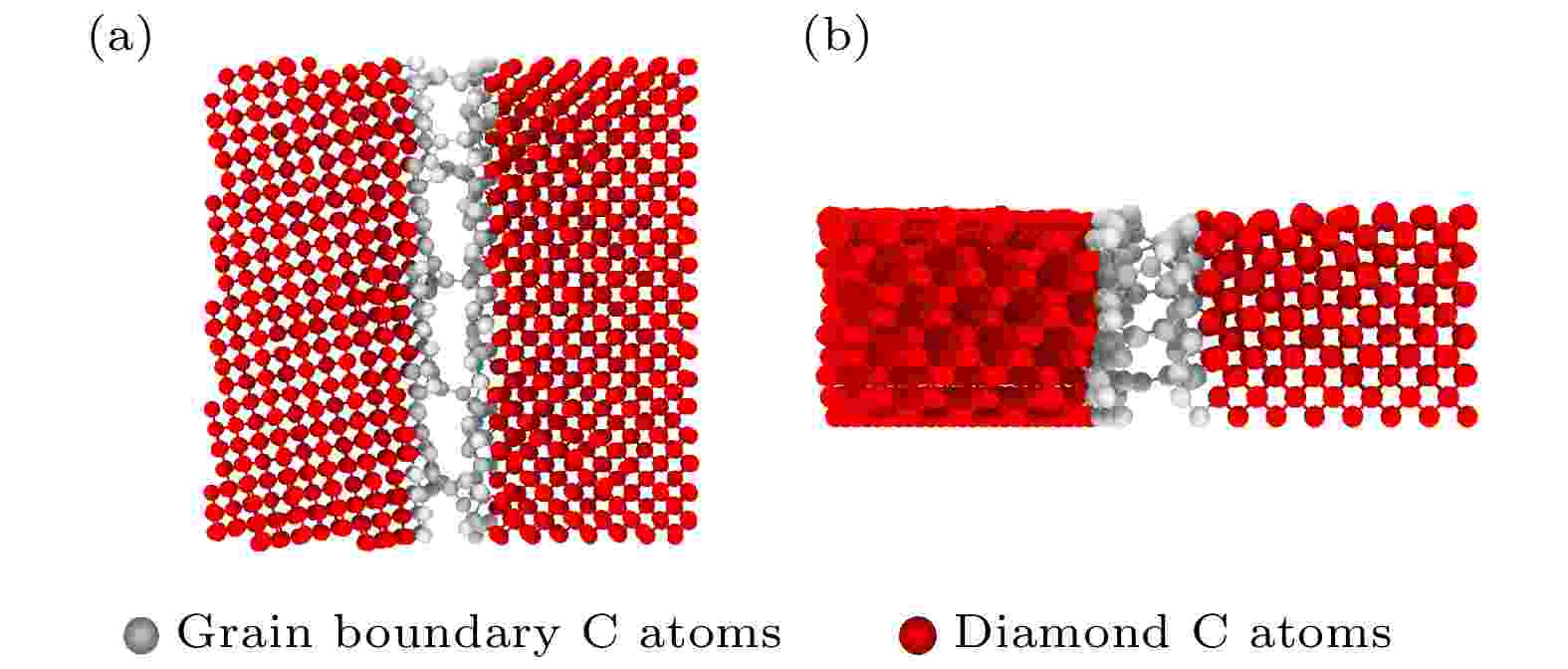
2022, 71 (8): 086103.
doi: 10.7498/aps.71.20211981
Abstract +
The growth of high-quality graphene is always a focused issue in the field of two-dimensional materials, and the growth of graphene on brand new substrates has received considerable attention from scholars especially. The research on the nucleation mechanism of graphene deposited on a polycrystalline diamond substrate is of significance in the large-scale preparation of graphene in practice. Here in this work, the direct growth without transfer process of graphene on a diamond substrate is used to obtain the high-quality graphene. The reactive molecular dynamics simulation technology is adopted to imitate the process of graphene deposition and growth on bi-crystal diamond assisted by nickel catalyzed at an atomic level. The effect of the bi-crystal diamond grain boundary on the dynamic behavior of graphene nucleation and growth process is studied. The results demonstrate that the grain boundary carbon atoms can be used as a supplementary carbon source to diffuse into the nickel free surface and participate in the nucleation and growth of graphene. Furthermore, the effect of temperature on the diffusion behavior of carbon atoms is explored, finding that high temperature facilitates the dissociation of atoms in the grain boundary. When the deposition temperature equals 1700 K, it is most conducive to the diffusion of grain boundary carbon atoms in the nickel lattice, which effectively enhances the nucleation density of graphene. Besides, the effect of the deposition carbon source flow rate on the surface quality of graphene is explored, finding that the high-quality graphene surface can be obtained by adopting a lower carbon deposit rate of 1 ps–1 at 1700 K. In brief, the research results obtained not only provide an effective theoretical model and analysis of the mechanism for diamond grain boundary assisted graphene deposition and growth, but also reveal the regular pattern of influence of deposition temperature and deposition carbon source flow rate on the surface quality of synthesized graphene. The present study can lay a theoretical foundation for the fabrication and application of new functional graphene-polycrystalline diamond heterostructures in the fields of ultra-precision manufacturing and microelectronics.
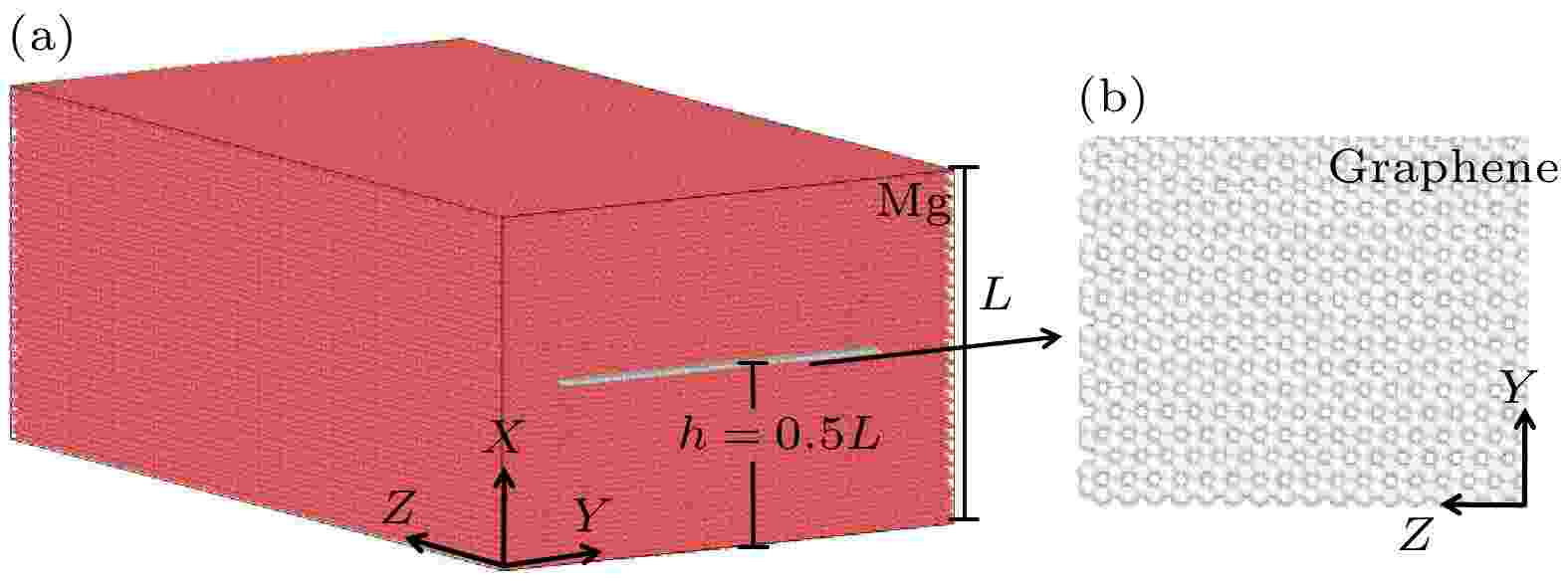
2022, 71 (8): 086201.
doi: 10.7498/aps.71.20211753
Abstract +
Magnesium alloy is regarded as a lightest engineering structural metal material due to its low density, but its wide application is limited due to poor plastic deformation behavior. Therefore, the comprehensive mechanical properties of enhanced magnesium alloy have become a research focus in the material science. Here, the effect of graphene on the deformation behavior and that on the mechanical properties of magnesium under tensile loading are studied by molecular dynamics simulation. The results show that the introduction of graphene can significantly improve the mechanical properties of pure magnesium. Comparing with pure magnesium, the Young's modulus and the first peak stress of the graphene magnesium matrix (GR/Mg) composites are increased by about 27.5% and 36.5% respectively, which is mainly due to the excellent mechanical properties of graphene. The results also indicate that the embedded position of graphene has little effect on the Young's modulus or peak stress of the GR/Mg composites, but it will significantly affect the plastic deformation behavior of the GR/Mg composites after the second peak stress. With the increase of the embedded height of graphene, the average flow stress of the GR/Mg composites first increases in the later stage of plastic deformation. When the embedded height reaches 0.4L, the average flow stress of the GR/Mg composites reaches a maximum value, and then decreases. This phenomenon of the Gr/Mg composites can be explained by the plastic deformation behavior of the magnesium matrix above and below graphene. The embedded position of graphene has a great influence on the plastic deformation behavior of the upper and lower magnesium matrix of the GR/Mg composites. When the embedded height of graphene is small, the plastic deformation capability of magnesium matrix under graphene is strong and dislocation slip is easy to occur. And when the embedded height of graphene is large, the plastic deformation capabilities of the two parts of magnesium matrix above and below graphene are equal, and their plastic deformation behavior tends to be synchronous. The results show that the plastic deformation behavior of the GR/Mg composite is the same as that of pure magnesium, and the phase transition from HCP to BCC and then to HCP occurs in the process of the plastic deformation. The phase transition mechanism of magnesium matrix is also analyzed in detail. The results of this study have certain theoretical guiding significance in designing the high performance graphene metal matrix composites.

2022, 71 (8): 086301.
doi: 10.7498/aps.71.20212144
Abstract +
The mechanical properties of ultra-high strength martensite steel strongly depend on the shape, size and content of the reversed austenite. In general, the plasticity and toughness of the materials can be improved effectively by increasing the content of the reversed austenite. After aging treatment of Cu-bearing as-quenched steel with martensitic microstructure, Cu particles precipitate at the boundary of martensitic structure and act as heterogeneous nucleation sites to promote the nucleation of reversed austenite. In order to explore the effects of different alloying elements on heterogeneous nucleation of reversed austenite on Cu particles, the effects of X (X = Cr, Al, Mo, W, Ni, Co, Mn) on the interfacial properties of Cu/γ-Fe are studied via first-principles method. The adhesion work, interfacial energy and electronic structure of the interfaces before and after the replacement of Cu and Fe atoms at Cu/γ-Fe boundaries are calculated. The results show that when the alloying elements replace Cu atoms at the Cu/γ-Fe interface, strong X—Fe covalent bond forms at the Cu/γ-Fe interface, the adhesion work increases and the interfacial energy decreases, and thus improve the heterogeneous nucleation capability of reverted γ-Fe on Cu particles. When Fe atoms at the interface are replaced, the stability of the interface changes little, and the bonding between the doped atoms and the neighboring atoms is weak.
CONDENSED MATTER: ELECTRONIC STRUCTURE, ELECTRICAL, MAGNETIC, AND OPTICAL PROPERTIES
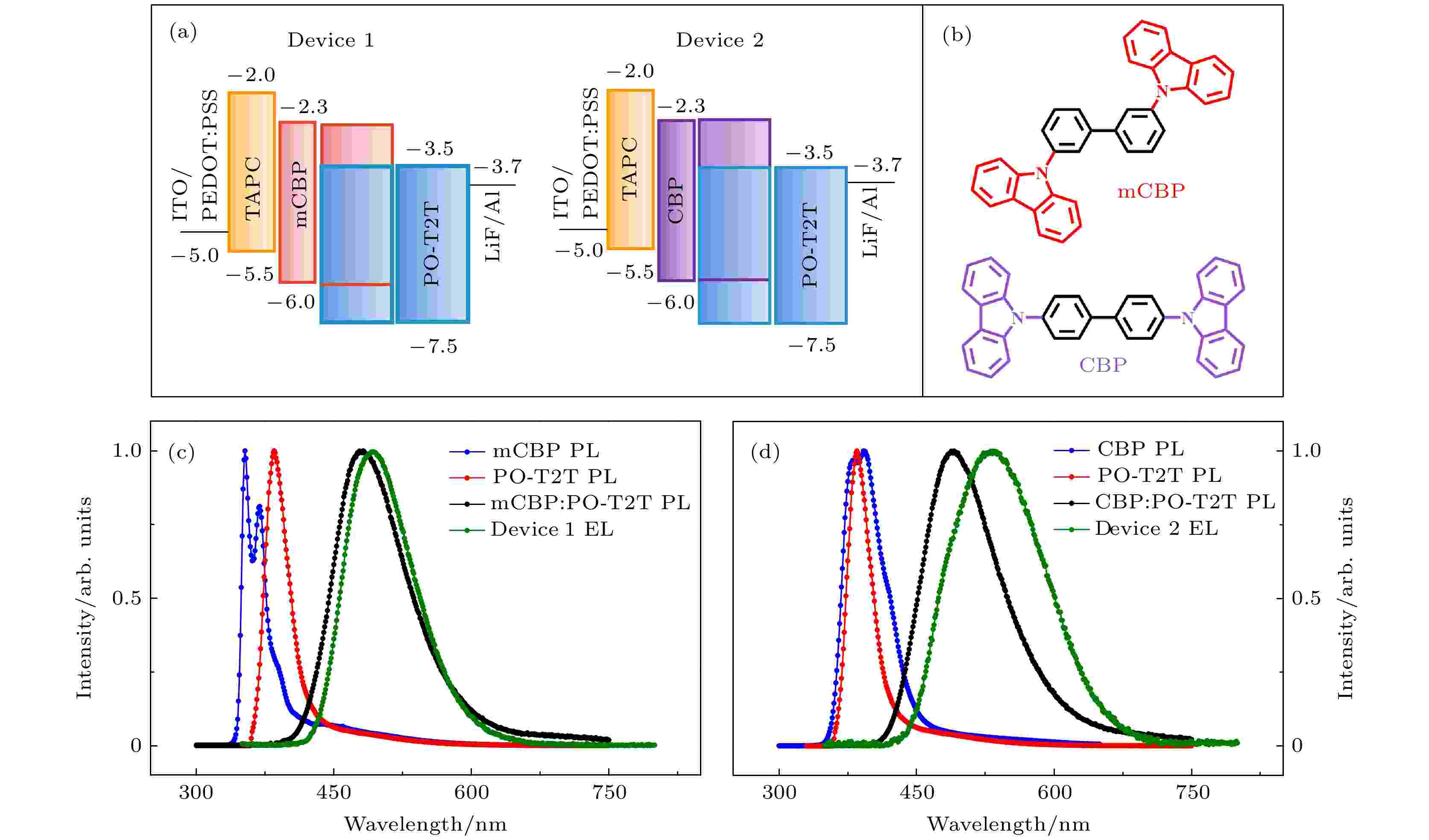
EDITOR'S SUGGESTION
2022, 71 (8): 087201.
doi: 10.7498/aps.71.20212068
Abstract +
The mCBP and CBP are two kinds of isomers containing carbazole groups and often used as the device hosts for fluorescence and phosphorescence emission. However, there are little studies on the microscopic mechanisms of exciplex-type devices based on mCBP or CBP. In this paper, the isomers of mCBP and CBP are used as donors and the PO-T2T is selected as an acceptor. The two kinds of exciplex-based devices are fabricated according to a mass ratio of 1∶1, which are respectively referred to as device 1 (Dev. 1) and device 2 (Dev. 2). Their magneto-electroluminescence (MEL) curves are measured at different working temperatures and various injection currents. It is found that the low field effects of the MEL curves from Dev. 1 are dominated by the B-mediated reverse intersystem crossing (RISC) process at room temperature, and as the operational temperature decreases, the MEL line-shapes change gradually from RISC to the intersystem crossing (ISC) process. Conversely, the low field effects of the MEL curves of Dev. 2 are governed by the B-mediated ISC process at room temperature, and the ISC process first weakens then strengthens with temperature decreasing. The high field effects of the MEL curves of Dev. 1 and Dev. 2 are both dominated by the B-mediated triplet-charge annihilation (TQA) process at room temperature, but those of Dev. 2 at 20 K present the B-mediated triplet-triplet annihilation (TTA) process. The completely opposite low-field line-shapes of MEL traces from Dev. 1 and Dev. 2 can be attributed to their different structures of mCBP and CBP, which lead to the higher and lower triplet state exciton energy, respectively. The higher triplet exciton energy of the mCBP donor causes the triplet exciplex energy to be confined effectively, which promotes the RISC process (EX1 ← EX3) in Dev.1. Contrarily, the lower triplet exciton energy of the CBP donor causes the triplet exciplex to experience an energy loss process (EX3 → T1, CBP) , resulting in the suppressed RISC process in Dev. 2. Consequently, the overlapped effects of the ISC process of polaron pairs and the RISC process of exciplex in Dev. 2 under the action of external magnetic field display the ISC-determined process at room temperature. Moreover, the temperature-dependent change in the microscopic process of Dev. 1 such as the conversion from RISC to ISC is because decreasing temperature is not conducive to the occurrence of the RISC process of exciplex states due to its endothermic property. The low-temperature TTA process occurring in Dev. 2 is due to the suppressed energy loss process of triplet exciplex via the Dexter energy transfer from the triplet exciplex to the triplet exciton of CBP donor. In addition, when the mass ratio of mCBP donor to PO-T2T acceptor varies from 1∶4 to 1∶1 to 4∶1, the RISC process of MEL curves of devices turns stronger and stronger, which is because the devices tend more to balance, favoring the RISC process. A higher external quantum efficiency is obtained in the mCBP:PO-T2T host than in the CBP:PO-T2T host when fluorescent guest material of TBRb is used as a dopant in these two exciplex-based devices, which verifies the importance of the effective confinement of triplet exciplex energy in improving the luminescence efficiency. Note that via the MEL detection technology, the current- and temperature-dependent microscopic processes and their reasonable interpretations and device performances from exciplex-based devices with the isomers of mCBP and CBP as donors have not been reported in the literature. This work provides experimental and theoretical references for fabricating the high-efficiency exciplex-based organic light-emitting devices.
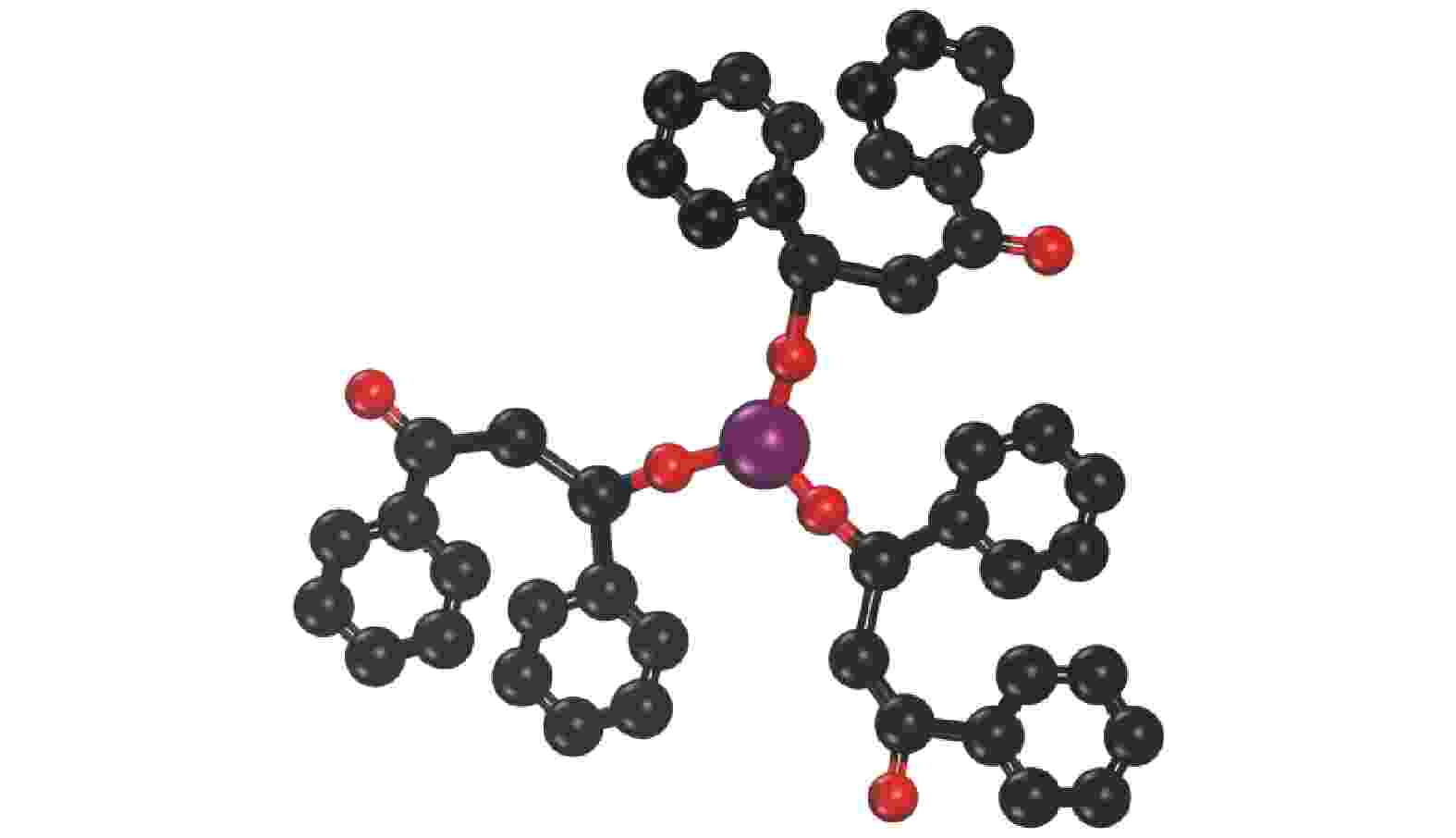
2022, 71 (8): 087501.
doi: 10.7498/aps.71.20212128
Abstract +
Synthesis and exploration of intriguing physical properties of alkali-metal-doped aromatic hydrocarbons have been the important research topics in the fields of physics, chemistry and materials science. In this work, a powder sample of potassium-doped tris(diphenacyl) iron molecular crystal is prepared by the high-vacuum annealing method. The X-ray diffraction results show that the crystal structure of the synthesized sample is different from that of pristine tris(diphenacyl)iron. The direct current (DC) magnetic susceptibilitiy shows a pronounced hump structure near 8.0 K, which is distinct from the paramagnetism of pristine material in the whole temperature range of 1.8–300 K. The alternating current (AC) magnetic susceptibility shows that the hump has a significant frequency dependence, which can safely rule out the possibility of antiferromagnetism. The combination of the Vogel-Fulcher law, the Néel-Brown model and the critical slowing down model reveals that the hump originates from superparamagnetism with a blocking temperature (TB) of about 8.0 K. According to the results of Raman spectroscopy, it can be confirmed that the 4s electrons of potassium in the doped material are transferred to the benzene ring of tris(diphenacyl)iron, causing the characteristic Raman modes to be red-shifted and the local magnetic moment to form. Our work is of great significance in exploring alkali-metal-doped aromatic hydrocarbons, and provides a new route for searching organic magnetic materials.

COVER ARTICLE
2022, 71 (8): 087801.
doi: 10.7498/aps.71.20212358
Abstract +
Transition metal dichalcogenide (TMDC) monolayers have direct band gaps and can produce strong photoluminescence(PL), thereby possessing a wide application prospect in photoelectric devices and photoelectric detection fields. However, their PL efficiency needs further improving because they are of atomic thickness only, besides, they have non-radiative recombination of excitons. In this study, a combination structure of a gold film, titanium dioxide subwavelength gratings and TMDC monolayers is designed, which can greatly improve PL efficiency of the TMDC monolayers. The spontaneous emission rate can be controlled by the Purcell effect, and the maximum enhancement of photoluminescence is as high as 3.4 times. In this paper, the PL signals of monolayer WS2 and monolayer WSe2 on the designed structure are studied. The feasibility of the enhancement of PL of the TMDC monolayers on the subwavelength grating structure is verified experimentally, which provides a new idea for the application of two-dimensional materials to optoelectronic devices.
INTERDISCIPLINARY PHYSICS AND RELATED AREAS OF SCIENCE AND TECHNOLOGY
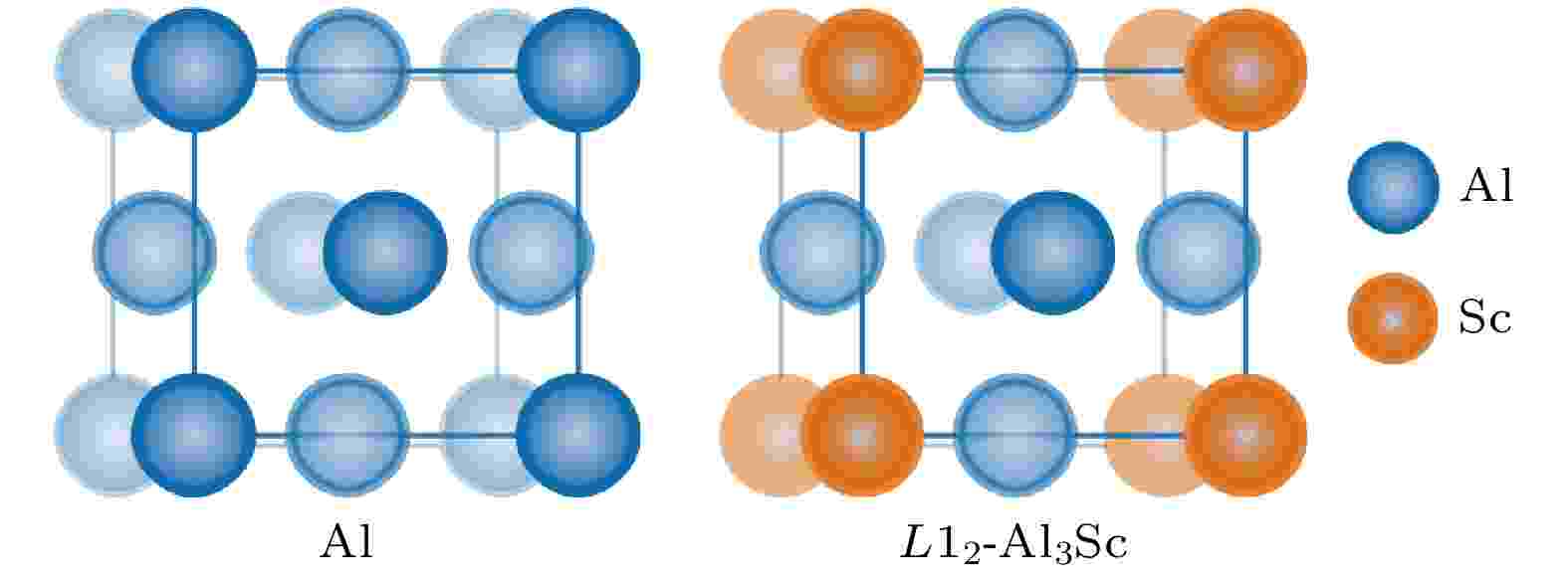
2022, 71 (8): 088101.
doi: 10.7498/aps.71.20212156
Abstract +
Thermal stabilities of L12-Al3Sc nano-precipitates are critical for the thermotolerance of Al-Sc based alloys. Previous experiments have suggested that different alloying elements may have different segregation behaviors at the L12-Al3Sc/Al interface, which can exert different influences on the thermal stability of L12-Al3Sc nano-precipitates. To clarify the responsible mechanism from a quantitative approach, first-principles calculations of energetics are performed in this work, to investigate the segregation behaviors of transition-metal elements Cu and Ti at the L12-Al3Sc/Al interface. The results suggest that both Cu and Ti can segregate to the interface, and substitute Al or Sc sites on its Al side with different thermodynamic driving forces. Given a temperature, segregation amount is largely determined by the initial elemental concentration in the Al matrix. The higher the segregation driving force and the initial matrix concentration are, the higher the equilibrium segregation amount (or the maximum interfacial coverage) could be. With an initial matrix atomic concentration of 1%, the maximum interfacial coverage of Ti can reach up to 80% (0.8 monolayer layer (ML)) while that of Cu is less than 4% (0.04 ML) at T = 600 K.
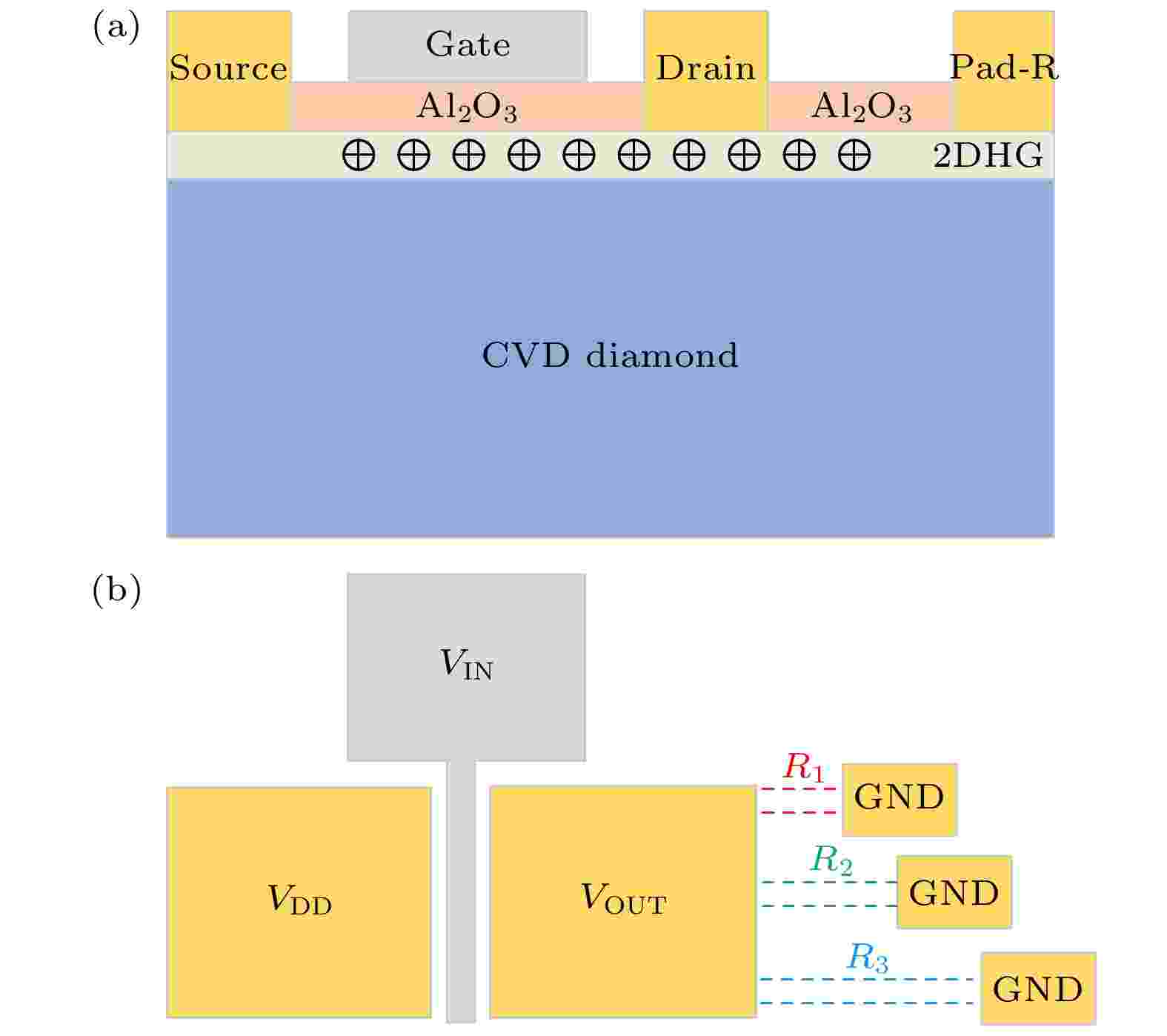
EDITOR'S SUGGESTION
2022, 71 (8): 088102.
doi: 10.7498/aps.71.20211447
Abstract +
Diamond has a wide band gap, high carrier mobility, and high thermal conductivity, thereby possessing great potential applications in high power, and high temperature electronics devices, and also inhigh temperature logic circuit. In this work, we fabricate a hydrogen terminated diamond metal-oxide-semiconductor field effect transistor (MOSFET) by using the atomic layer deposition grown Al2O3 as a gate dielectric and passivation layer. The device has a gate length and width of 4 μm and 50 μm, respectively. The device delivers a maximum output current of about 113.4 mA/mm at VGS of –6 V and an ultra-high on/off ratio of 109. In addition, we fabricate three resistors, respectively, with an interelectrode distance of 20, 80 and 160 μm, corresponding to the resistance value of 16.7, 69.5 and 136.4 kΩ, respectively. The logic inverter is realized by combining the MOSFET with the load resistance, and the characteristics of the logic inverter are demonstrated successfully, which indicates that the diamond MOSFET has great potential applications in future logic circuits.
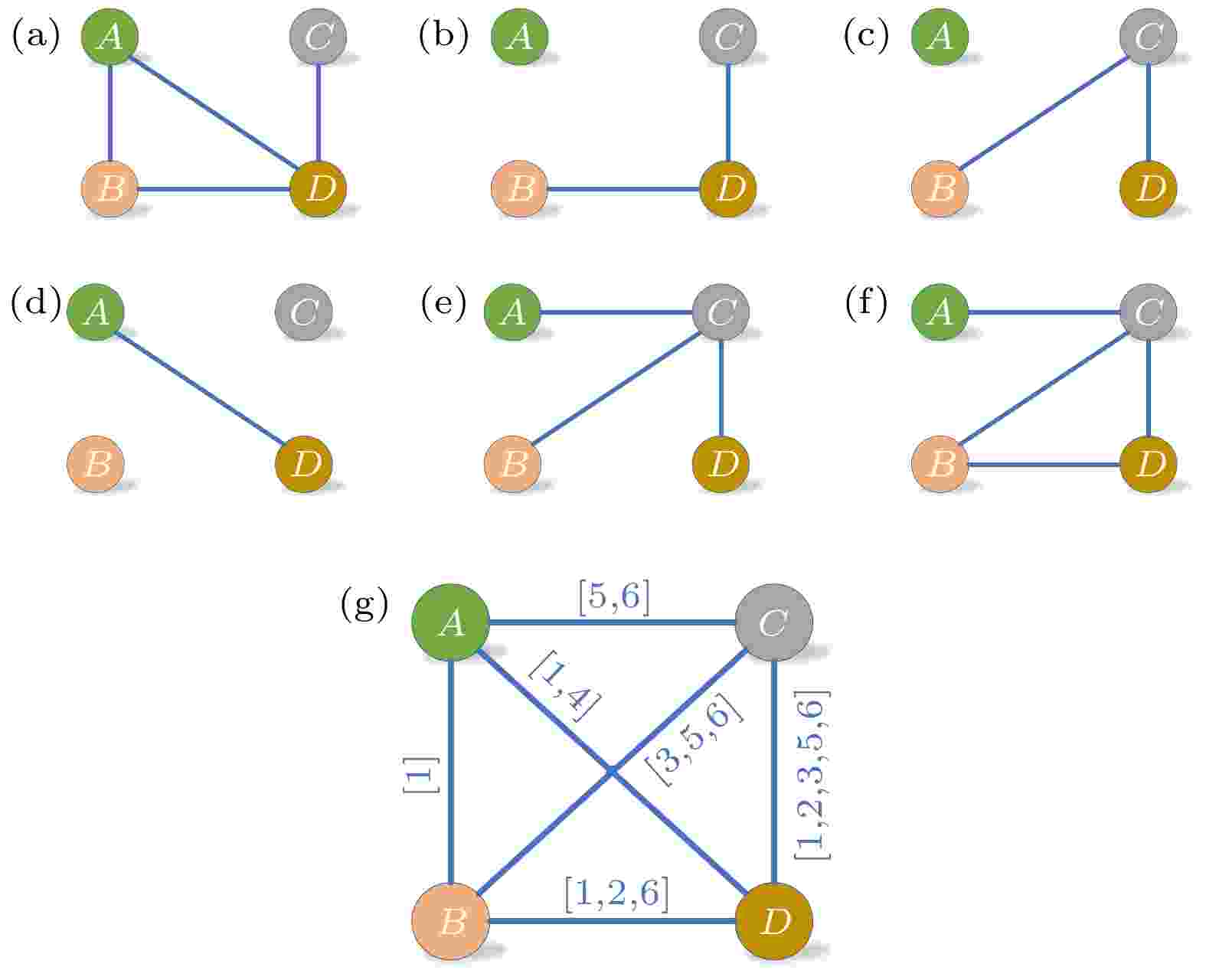
2022, 71 (8): 088901.
doi: 10.7498/aps.71.20212106
Abstract +
With the development of network science, the static network has been unable to clearly characterize the dynamic process of the network. In real networks, the interaction between individuals evolves rapidly over time. This network model closely links time to interaction process. Compared with static networks, dynamic networks can clearly describe the interaction time of nodes, which has more practical significance. Therefore, how to better describe the behavior changes of networks after being attacked based on time series is an important problem in the existing cascade failure research. In order to better answer this question, a failure model based on time series is proposed in this paper. The model is constructed according to time, activation ratio, number of edges and connection probability. By randomly attacking nodes at a certain time, the effects of four parameters on sequential networks are analyzed. In order to validate the validity and scientificity of this failure model, we use small social networks in the United States. The experimental results show that the model is feasible. The model takes into account the time as well as the spreading dynamics and provides a reference for explaining the dynamic networks in reality.
GEOPHYSICS, ASTRONOMY, AND ASTROPHYSICS

2022, 71 (8): 089101.
doi: 10.7498/aps.71.20211463
Abstract +
When elastic waves propagate in an unsaturated porous medium, the macro Biot flow, micro squirt flow, and meso flow will occur. The unsaturated porous medium is equivalent to the inclusion of gas phase porous fluid embedded in the background medium containing liquid phase porous fluid. Based on the unsaturated dual porous medium model, the micro squirt flow is introduced, and the wave propagation equation of unsaturated porous medium including macro, micro and mesoscopic scale wave introduced flow is established. The numerical analysis indicates that the model in this paper can better predict the wave velocity dispersion and attenuation in a wider frequency band.
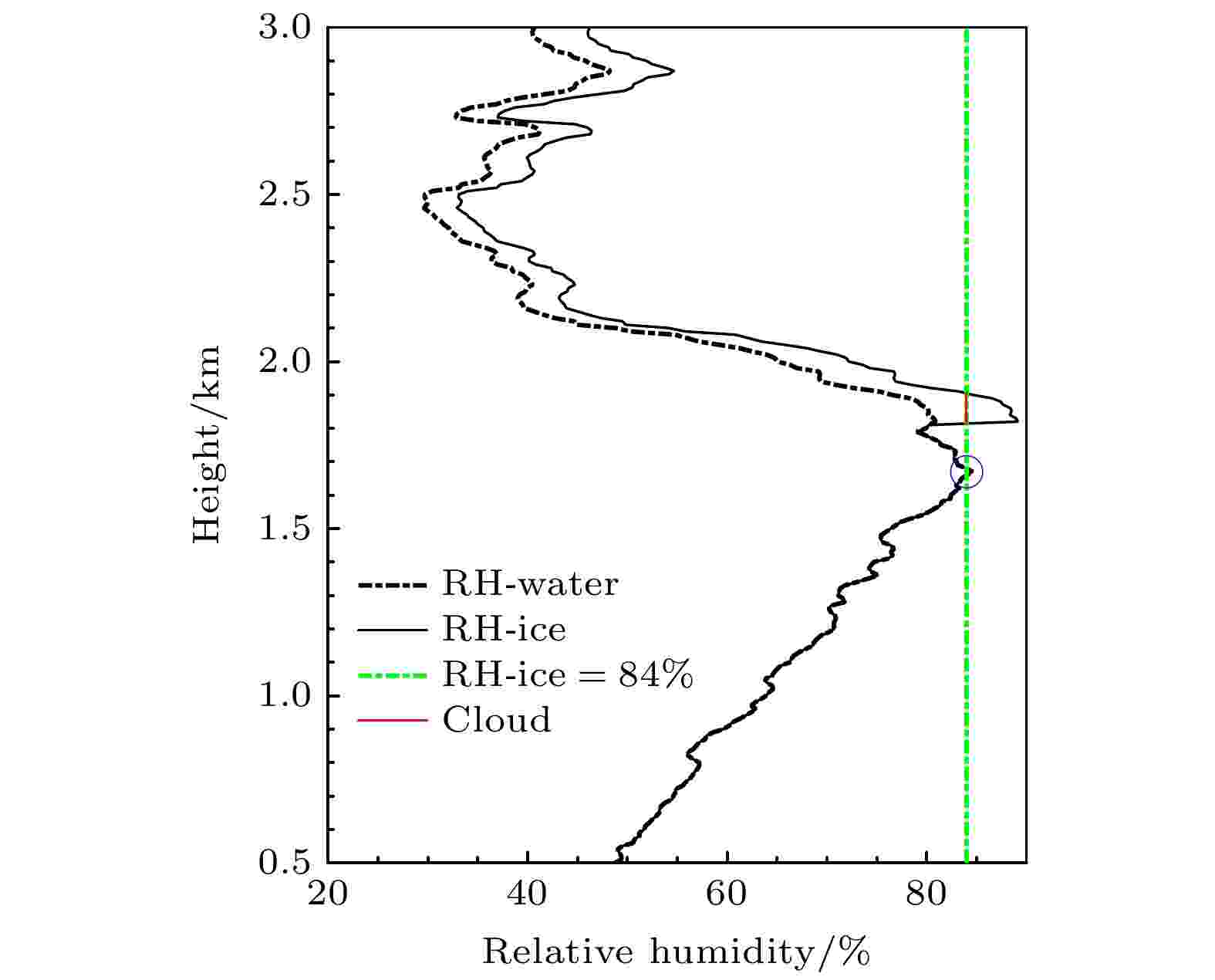
2022, 71 (8): 089202.
doi: 10.7498/aps.71.20211792
Abstract +
Based on the measured thermal radiosondes, the WR95 method is used to identify the vertical structure of low clouds. The atmospheric refractive index structure constant$C_{n}^2$ , meteorological conditions and atmospheric stability are contrastively analyzed under cloudy and clear sky weather. The results show that the influence of low-level thin clouds on the fluctuation of $ C_n^2 $ is negligible, showing only a slight increase trend. The $ C_n^2 $ at low-level thin clouds base and top is about 1.6 and 2.5 times that under clear sky weather to a greatest extent, respectively. The $ C_n^2 $ at the low-level medium-thick clouds top is 3.8–6.61 times the amplitude of that under clear sky weather, and enhanced amplitude of $ C_n^2 $ near the cloud top is greater than that near the cloud base. Atmospheric turbulence near the cloud base is driven by the combined effect of ground heat and low clouds cooling. The sinking airflow from clouds is coupled with the upward airflow from ground, which motivates wind shear, resulting $ C_n^2 $ increases near this height. A comprehensive comparison of the $ C_n^2 $ between clear sky and cloudy weather shows that the enhancement effect of clouds on $ C_n^2 $ is roughly on the order of 10–16. Wind shear reaches its maximum value at or above the cloud top. Because of the combined effect of short-wave radiation warming and long-wave radiation cooling near the cloud top, temperature inversion layers with different thickness will be formed obove the cloud top, resulting in a sharp increase in the potential temperature lapse rate at the cloud top, and the Brunt-Vaisala frequency $ {N^2} $ is increased by 0.5–3.0 times. And $ {N^2} $ near the cloud base is less than that under the clear sky weather. Owing to the turbulent effect caused by cloud multi-scale activities, it is inevitable to cause assessment and correction deviations in the laser transmission. A deep understanding of how turbulence behave within different phase clouds or around cloud boundaries can also lay the foundation for further modeling the atmospheric turbulence around clouds.














